Elasticsearch Quick Guide
User Manual:
Open the PDF directly: View PDF ![]() .
.
Page Count: 71

Previous Page Next Page
Elasticsearch - Quick GuideElasticsearch - Quick Guide
Elasticsearch - Quick Guide
Advertisements
Elasticsearch - Basic ConceptsElasticsearch - Basic Concepts
Elasticsearch - Basic Concepts
Elasticsearch is an Apache Lucene-based search server. It was developed by Shay Banon
and published in 2010. It is now maintained by Elasticsearch BV. Its latest version is 2.1.0.
Elasticsearch is a real-time distributed and open source full-text search and analytics
engine. It is accessible from RESTful web service interface and uses schema less JSON
(JavaScript Object Notation) documents to store data. It is built on Java programming
language, which enables Elasticsearch to run on different platforms. It enables users to
explore very large amount of data at very high speed.
The general features of Elasticsearch are as follows −
Elasticsearch is scalable up to petabytes of structured and unstructured data.
Elasticsearch can be used as a replacement of document stores like MongoDB and
RavenDB.
Elasticsearch uses denormalization to improve the search performance.
Elasticsearch is one of the popular enterprise search engines, which is currently
being used by many big organizations like Wikipedia, The Guardian, StackOverflow,
GitHub etc.
Elasticsearch is open source and available under the Apache license version 2.0.
The key concepts of Elasticsearch are as follows −
Elasticsearch – General FeaturesElasticsearch – General Features
Elasticsearch – General Features
Elasticsearch – Key ConceptsElasticsearch – Key Concepts
Elasticsearch – Key Concepts

Node − It refers to a single running instance of Elasticsearch. Single physical and
virtual server accommodates multiple nodes depending upon the capabilities of
their physical resources like RAM, storage and processing power.
Cluster − It is a collection of one or more nodes. Cluster provides collective
indexing and search capabilities across all the nodes for entire data.
Index − It is a collection of different type of documents and document properties.
Index also uses the concept of shards to improve the performance. For example, a
set of document contains data of a social networking application.
Type/Mapping − It is a collection of documents sharing a set of common fields
present in the same index. For example, an Index contains data of a social
networking application, and then there can be a specific type for user profile data,
another type for messaging data and another for comments data.
Document − It is a collection of fields in a specific manner defined in JSON
format. Every document belongs to a type and resides inside an index. Every
document is associated with a unique identifier, called the UID.
Shard − Indexes are horizontally subdivided into shards. This means each shard
contains all the properties of document, but contains less number of JSON objects
than index. The horizontal separation makes shard an independent node, which
can be store in any node. Primary shard is the original horizontal part of an index
and then these primary shards are replicated into replica shards.
Replicas − Elasticsearch allows a user to create replicas of their indexes and
shards. Replication not only helps in increasing the availability of data in case of
failure, but also improves the performance of searching by carrying out a parallel
search operation in these replicas.
Elasticsearch is developed on Java, which makes it compatible on almost every
platform.
Elasticsearch is real time, in other words after one second the added document is
searchable in this engine.
Elasticsearch is distributed, which makes it easy to scale and integrate in any big
organization.
Creating full backups are easy by using the concept of gateway, which is present in
Elasticsearch.
Handling multi-tenancy is very easy in Elasticsearch when compared to Apache
Solr.
Elasticsearch – AdvantagesElasticsearch – Advantages
Elasticsearch – Advantages

Elasticsearch uses JSON objects as responses, which makes it possible to invoke
the Elasticsearch server with a large number of different programming languages.
Elasticsearch supports almost every document type except those that do not
support text rendering.
Elasticsearch does not have multi-language support in terms of handling request
and response data (only possible in JSON) unlike in Apache Solr, where it is
possible in CSV, XML and JSON formats.
Elasticsearch also have a problem of Split brain situations, but in rare cases.
In Elasticsearch, index is a collection of type just as database is a collection of tables in
RDBMS (Relation Database Management System). Every table is a collection of rows just
as every mapping is a collection of JSON objects Elasticsearch.
Elasticsearch RDBMS
Index Database
Shard Shard
Mapping Table
Field Field
JSON Object Tuple
Elasticsearch - InstallationElasticsearch - Installation
Elasticsearch - Installation
The steps for installation of Elasticsearch are as follows −
Step 1 − Check the minimum version of your java in installed your computer, it should be
java 7 or more updated version. You can check by doing the following −
In Windows Operating System (OS) (using command prompt) −
> java -version
In UNIX OS (Using Terminal) −
$ echo $JAVA_HOME
Step 2 − Download Elasticsearch from www.elastic.co
Elasticsearch – DisadvantagesElasticsearch – Disadvantages
Elasticsearch – Disadvantages
Comparison between Elasticsearch and RDBMSComparison between Elasticsearch and RDBMS
Comparison between Elasticsearch and RDBMS

For windows OS download ZIP file.
For UNIX OS download TAR file.
For Debian OS download DEB file.
For Red Hat and other Linux distributions download RPN file.
APT and Yum utilities can also be used to install Elasticsearch in many Linux distributions.
Step 3 − Installation process for Elasticsearch is very easy and described below for
different OS −
Windows OS − Unzip the zip package and the Elasticsearch is installed.
UNIX OS − Extract tar file in any location and the Elasticsearch is installed.
$tar –xvf elasticsearch-2.1.0.tar.gz
Using APT utility for Linux OS −
Download and install the Public Signing Key −
$ wget -qO - https://packages.elastic.co/GPG-KEY-elasticsearch | sudo apt-key add -
Save the repository definition −
$ echo "deb http://packages.elastic.co/elasticsearch/2.x/debian stable main" | sudo tee -a /etc
/apt/sources.list.d/elasticsearch-2.x.list
Run update −
$ sudo apt-get update
Now you can install by using the following command −
$ sudo apt-get install elasticsearch
Using YUM utility for Debian Linux OS −
Download and install the Public Signing Key −
$ rpm --import https://packages.elastic.co/GPG-KEY-elasticsearch
ADD the below text in the file with .repo suffix in your “/etc/yum.repos.d/”
directory. For example, elasticsearch.repo
[elasticsearch-2.x]
name = Elasticsearch repository for2.x packages

baseurl = http://packages.elastic.co/elasticsearch/2.x/centos
gpgcheck = 1
gpgkey = http://packages.elastic.co/GPG-KEY-elasticsearch
enabled = 1
You can now install Elasticsearch by using the following command −
$ yum install elasticsearch
Step 4 − Go to the Elasticsearch home directory and inside the bin folder. Run the
elasticsearch.bat file in case of windows or you can do the same using command prompt
and through terminal in case of UNIX rum Elasticsearch file.
In Windows −
> cd elasticsearch-2.1.0/bin
> elasticsearch
In Linux −
$ cd elasticsearch-2.1.0/bin
$ ./elasticsearch
Note − in case of windows, you might get error stating JAVA_HOME is not set, please set
it in environment variables to “C:\Program Files\Java\jre1.8.0_31” or the location where
you installed java.
Step 5 − Default port for Elasticsearch web interface is 9200 or you can change it by
changing http.port inside elasticsearch.yml file present in bin directory. You can check if
the server is up and running by browsing http://localhost:9200. It will return a JSON
object, which contains the information about the installed Elasticsearch in the following
way −
{
"name" : "Brain-Child",
"cluster_name" : "elasticsearch", "version" : {
"number" : "2.1.0",
"build_hash" : "72cd1f1a3eee09505e036106146dc1949dc5dc87",
"build_timestamp" : "2015-11-18T22:40:03Z",
"build_snapshot" : false,
"lucene_version" : "5.3.1"
},
"tagline" : "You Know, for Search"
}
Step 6 − You can install fiddler2 from www.telerik.com as a front end for your
Elasticsearch.
In the configure window of fiddler2, you can hit the address of Elasticsearch adding
an index and if you want, then the type/mapping also using HTTP POST method,
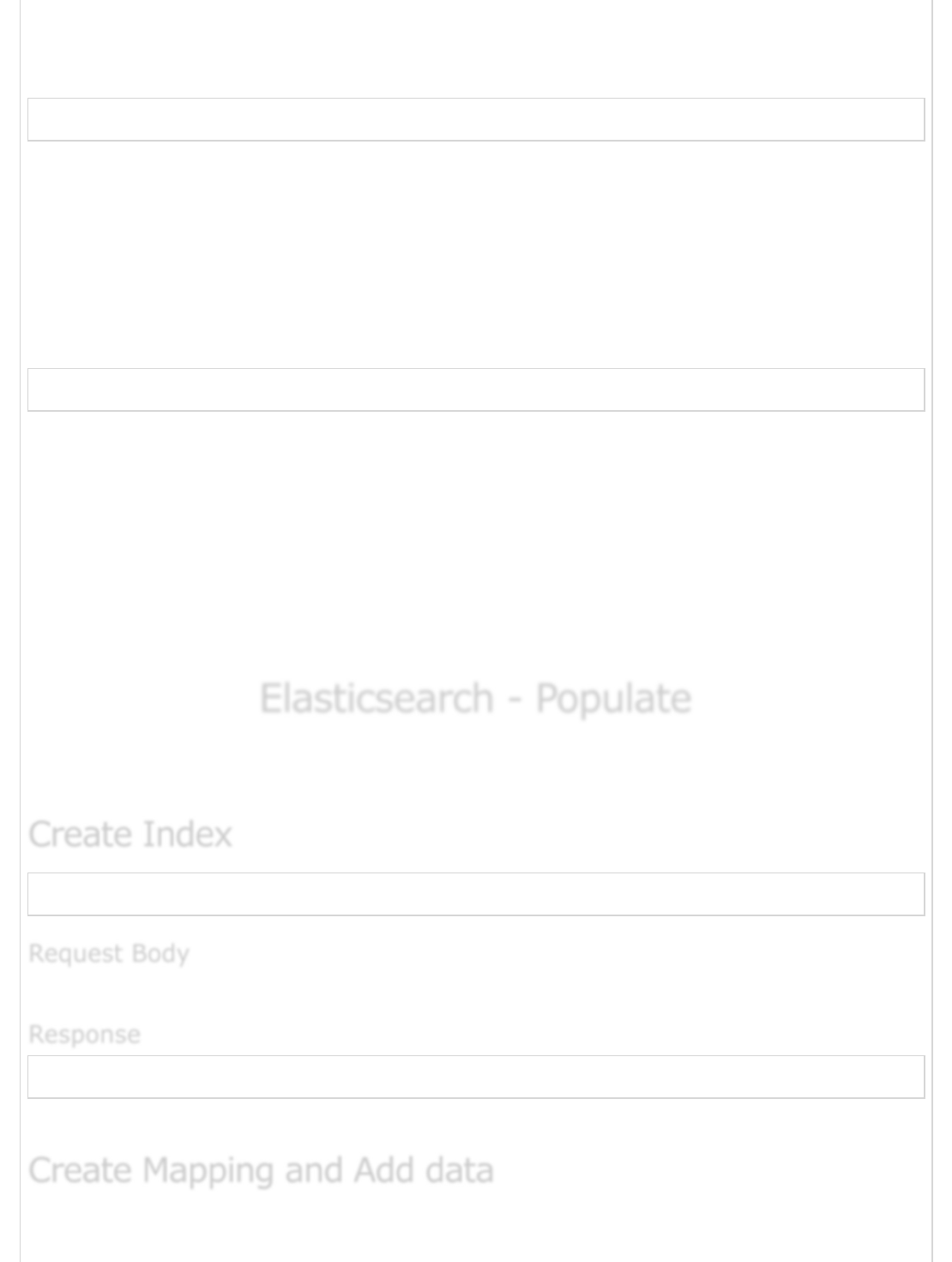
for example −
Address bar
http://localhost:9200/schools/school
Request body − You can add JSON object, which will get store into that
index.
You can use the same for searching anything by just adding “_search” keyword at
the end of URL and sent a query in request body for example −
Address bar
POST http://localhost:9200/city/schools/_search
Request body
{ "query":{ "match_all":{} } }
This query will return everything from that index, which belongs to that
particular type.
You can delete a particular index or type by just putting the URL of the same in
address bar and hit it with HTTP DELETE method.
Elasticsearch - PopulateElasticsearch - Populate
Elasticsearch - Populate
In this section, we will add some index, mapping and data to Elasticsearch. This data will
be used in the examples explained in this tutorial.
PUT http://localhost:9200/schools
It can contain index specific settings, but for now, it is empty for default settings.
{"acknowledged": true}
(This means index is created)
Create IndexCreate Index
Create Index
Request BodyRequest Body
Request Body
ResponseResponse
Response
Create Mapping and Add dataCreate Mapping and Add data
Create Mapping and Add data

Elasticsearch will auto-create the mapping according to the data provided in request body,
we will use its bulk functionality to add more than one JSON object in this index.
POST http://localhost:9200/schools/_bulk
{
"index":{
"_index":"schools", "_type":"school", "_id":"1"
}
}
{
"name":"Central School", "description":"CBSE Affiliation", "street":"Nagan",
"city":"paprola", "state":"HP", "zip":"176115", "location":[31.8955385, 76.8380405],
"fees":2000, "tags":["Senior Secondary", "beautiful campus"], "rating":"3.5"
}
{
"index":{
"_index":"schools", "_type":"school", "_id":"2"
}
}
{
"name":"Saint Paul School", "description":"ICSE
Afiliation", "street":"Dawarka", "city":"Delhi", "state":"Delhi", "zip":"110075",
"location":[28.5733056, 77.0122136], "fees":5000,
"tags":["Good Faculty", "Great Sports"], "rating":"4.5"
}
{
"index":{"_index":"schools", "_type":"school", "_id":"3"}
}
{
"name":"Crescent School", "description":"State Board Affiliation", "street":"Tonk Road",
"city":"Jaipur", "state":"RJ", "zip":"176114","location":[26.8535922, 75.7923988],
"fees":2500, "tags":["Well equipped labs"], "rating":"4.5"
}
{
"took":328, "errors":false,"items":[
{
"index":{
"_index":"schools", "_type":"school", "_id":"1", "_version":1, "_shards":{
"total":2, "successful":1, "failed":0
}, "status":201
}
},
{
"index":{
"_index":"schools", "_type":"school", "_id":"2", "_version":1, "_shards":{
Request BodyRequest Body
Request Body
ResponseResponse
Response

"total":2, "successful":1, "failed":0
}, "status":201
}
},
{
"index":{
"_index":"schools", "_type":"school", "_id":"3", "_version":1, "_shards":{
"total":2, "successful":1, "failed":0
}, "status":201
}
}
]
}
POST http://localhost:9200/schools_gov
It can contain index specific settings, but for now it’s empty for default settings.
{"acknowledged": true} (This means index is created)
POST http://localhost:9200/schools_gov/_bulk
{
"index":{
"_index":"schools_gov", "_type":"school", "_id":"1"
}
}
{
"name":"Model School", "description":"CBSE Affiliation", "street":"silk city",
"city":"Hyderabad", "state":"AP", "zip":"500030", "location":[17.3903703, 78.4752129],
"fees":200, "tags":["Senior Secondary", "beautiful campus"], "rating":"3"
}
{
"index":{
"_index":"schools_gov", "_type":"school", "_id":"2"
}
}
Add another IndexAdd another Index
Add another Index
Create IndexCreate Index
Create Index
Request BodyRequest Body
Request Body
ResponseResponse
Response
Create Mapping and Add DataCreate Mapping and Add Data
Create Mapping and Add Data
Request BodyRequest Body
Request Body

{
"name":"Government School", "description":"State Board Affiliation",
"street":"Hinjewadi", "city":"Pune", "state":"MH", "zip":"411057",
"location": [18.599752, 73.6821995], "fees":500, "tags":["Great Sports"], "rating":"4"
}
{
"took":179, "errors":false, "items":[
{
"index":{
"_index":"schools_gov", "_type":"school", "_id":"1", "_version":1, "_shards":{
"total":2, "successful":1, "failed":0
}, "status":201
}
},
{
"index":{
"_index":"schools_gov", "_type":"school", "_id":"2", "_version":1, "_shards":{
"total":2, "successful":1, "failed":0
}, "status":201
}
}
]
}
Migration between VersionsMigration between Versions
Migration between Versions
In any system or software, when we are upgrading to newer version, we need to follow a
few steps to maintain the application settings, configurations, data and other things. These
steps are required to make the application stable in new system or to maintain the
integrity of data (prevent data from getting corrupt).
The following are the steps to upgrade Elasticsearch −
Read breaking changes docs from https://www.elastic.co/
Test the upgraded version in your non production environments like in UAT, E2E, SIT or
DEV environment.
Rollback to previous Elasticsearch version is not possible without data backup. A data
backup is recommended before upgrading to a higher version.
We can upgrade using full cluster restart or rolling upgrade. Rolling upgrade is for new
versions (for 2.x and newer). There is no service outage, when you are using rolling
upgrade method for migration.
ResponseResponse
Response

Old Version New Version Upgrading Method
0.90.x 2.x Full cluster restart
1.x 2.x Full cluster restart
2.x 2.y Rolling upgrade (y > x)
Take data backup before migration and follow the instructions to carry out the backup
process. The snapshot and restore module can be used to take backup. This module can
be used to take a snapshot of index or full cluster and can be stored in remote repository.
Before starting the backup process, a snapshot repository needs to be registered in
Elasticsearch.
PUT /_snapshot/backup1
{
"type": "fs", "settings": {
... repository settings ...
}
}
Note − The above text is a HTTP PUT request to
http://localhost:9200/_snapshot/backup1 (there can be an IP address of the remote
server instead of the localhost). Rest of the text is request body. You can do this easily
using fiddler2 and other web tools in Windows.
We use shared file system (type: fs) for backup; it needs to be registered in every master
and data nodes. We just need to add the path.repo variable having path of backup
repository as a value.
After we add the repository path, we need to restart the nodes and then registration can
be carried out by executing the following command −
PUT http://localhost:9200/_snapshot/backup1
{
"type": "fs", "settings": {
"location": "/mount/backups/backup1", "compress": true
}
}
This upgrade process includes the following steps −
Step 1 − Disable shard allocation process and turn off the node.
Snapshot and Restore ModuleSnapshot and Restore Module
Snapshot and Restore Module
Full Cluster RestartFull Cluster Restart
Full Cluster Restart

PUT http://localhost:9200/_cluster/settings
{
"persistent": {
"cluster.routing.allocation.enable": "none"
}
}
In case of upgrading 0.90.x to 1.x use the following request −
PUT http://localhost:9200/_cluster/settings
{
"persistent": {
"cluster.routing.allocation.disable_allocation": false,
"cluster.routing.allocation.enable": "none"
}
}
Step 2 − Make a synched flush to Elasticsearch −
POST http://localhost:9200/_flush/synced
Step 3 − On all nodes, kill all the elastic services.
Step 4 − Do the following on every node −
In Debian or Red Hat Node − rmp or dpkg can be used to upgrade the node by
installing new packages. Do not overwrite config files.
In Windows (zip file) or UNIX (tar file) − Extract the new version without
overwriting the config directory. You can copy the files from old installation or can
change path.conf or path.data.
Step 5 − Initiate the nodes again starting with the master node (nodes with node.master
set to true and node.data set to false) in the cluster. Wait for some time to establish a
cluster. You can check by monitoring the logs or using the following request −
GET _cat/health or http://localhost:9200/_cat/health
GET _cat/nodes or http://localhost:9200/_cat/health
Step 6 − Monitor the progress of formation of cluster by using GET _cat/health request
and wait for the yellow in response, the response will be something like this −
1451295971 17:46:11 elasticsearch yellow 1 1 5 5 0 0 5 0 - 50.0%
Step 7 − Enable the shard allocation process, which was disabled in Step 1, by using the
following request −
PUT http://localhost:9200/_cluster/settings
{
"persistent": {
"cluster.routing.allocation.enable": "all"
}
}
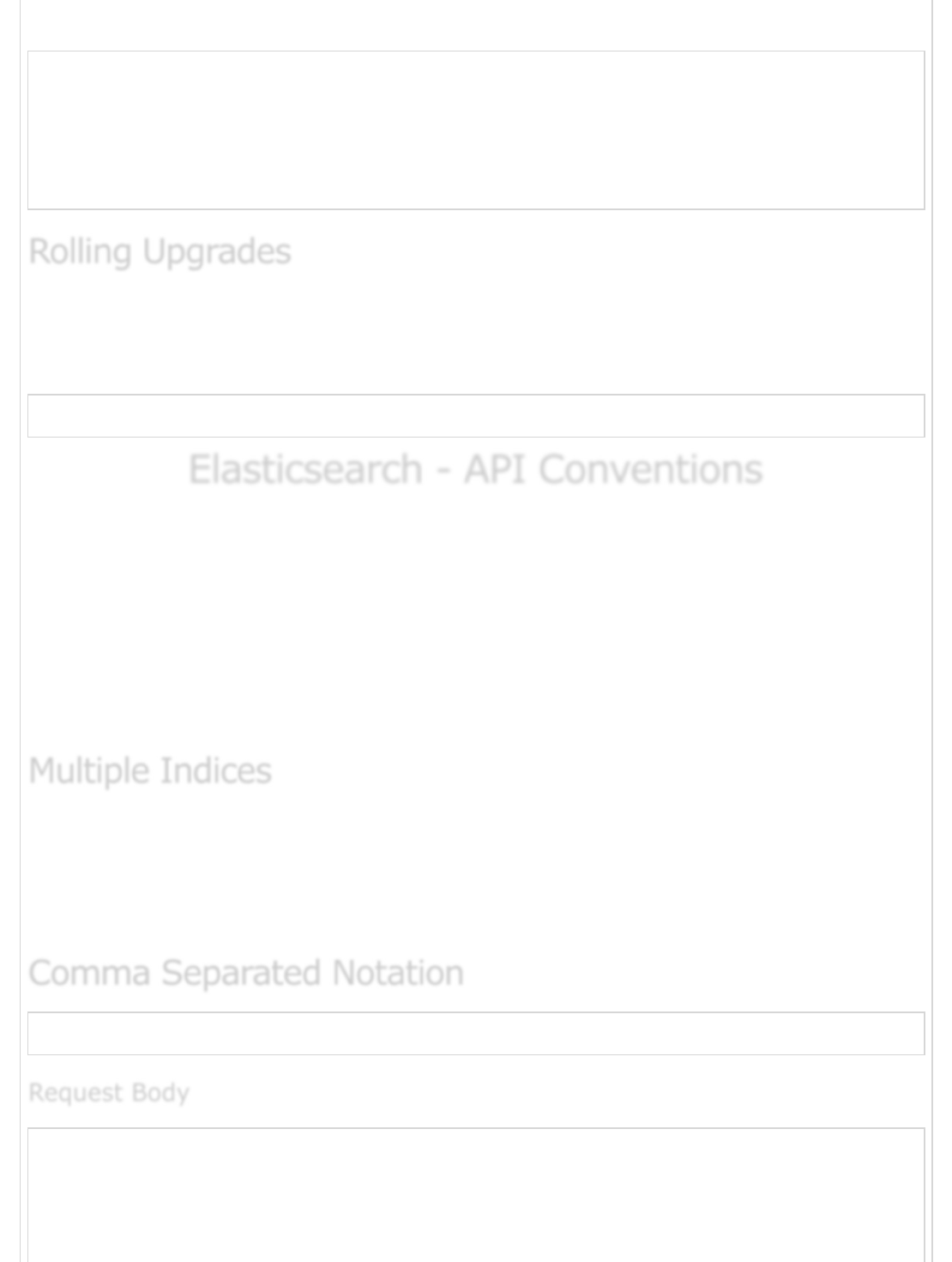
In case of upgrading 0.90.x to 1.x, use the following request −
PUT http://localhost:9200/_cluster/settings
{
"persistent": {
"cluster.routing.allocation.disable_allocation": true,
"cluster.routing.allocation.enable": "all"
}
}
It is same like Full cluster restart, except Step 3. Here, you stop one node and upgrade.
After upgrading, restart the node and repeat these for the all nodes. After enabling the
shard allocation process, it can be monitored by the following request −
GET http://localhost:9200/_cat/recovery
Elasticsearch - API ConventionsElasticsearch - API Conventions
Elasticsearch - API Conventions
Application Programming Interface (API) in web is a group of function calls or other
programming instructions to access the software component in that particular web
application. For example, Facebook API helps a developer to create applications by
accessing data or other functionalities from Facebook; it can be date of birth or status
update.
Elasticsearch provides a REST API, which is accessed by JSON over HTTP. Elasticsearch
uses the following conventions −
Most of the operations, mainly searching and other operations, in APIs are for one or more
than one indices. This helps the user to search in multiple places or all the available data
by just executing a query once. Many different notations are used to perform operations in
multiple indices. We will discuss a few of them here in this section.
POST http://localhost:9200/index1,index2,index3/_search
{
"query":{
"query_string":{
"query":"any_string"
}
Rolling UpgradesRolling Upgrades
Rolling Upgrades
Multiple IndicesMultiple Indices
Multiple Indices
Comma Separated NotationComma Separated Notation
Comma Separated Notation
Request BodyRequest Body
Request Body

}
}
JSON objects from index1, index2, index3 having any_string in it.
POST http://localhost:9200/_all/_search
{
"query":{
"query_string":{
"query":"any_string"
}
}
}
JSON objects from all indices and having any_string in it.
POST http://localhost:9200/school*/_search
{
"query":{
"query_string":{
"query":"CBSE"
}
}
}
JSON objects from all indices which start with school having CBSE in it.
Alternatively, you can use the following code as well −
POST http://localhost:9200/school*,-schools_gov /_search
ResponseResponse
Response
_all keyword for all indices_all keyword for all indices
_all keyword for all indices
Request BodyRequest Body
Request Body
ResponseResponse
Response
Wildcards ( * , + , – )Wildcards ( * , + , – )
Wildcards ( * , + , – )
Request BodyRequest Body
Request Body
ResponseResponse
Response
Request BodyRequest Body
Request Body

{
"query":{
"query_string":{
"query":"CBSE"
}
}
}
JSON objects from all indices which start with “school” but not from schools_gov and
having CBSE in it.
There are also some URL query string parameters −
ignore_unavailable − No error will occur or operation will not be stopped, if the
one or more index present in URL does not exist. For example, schools index exist
but book_shops does not exist −
POST http://localhost:9200/school*,book_shops/_search
{
"query":{
"query_string":{
"query":"CBSE"
}
}
}
{
"error":{
"root_cause":[{
"type":"index_not_found_exception", "reason":"no such index",
"resource.type":"index_or_alias", "resource.id":"book_shops",
"index":"book_shops"
}],
"type":"index_not_found_exception", "reason":"no such index",
"resource.type":"index_or_alias", "resource.id":"book_shops",
"index":"book_shops"
},"status":404
}
Take a look at the following code −
ResponseResponse
Response
Request BodyRequest Body
Request Body
ResponseResponse
Response

POST http://localhost:9200/school*,book_shops/_search?ignore_unavailable = true
{
"query":{
"query_string":{
"query":"CBSE"
}
}
}
JSON objects from all indices which start with school having CBSE in it.
true value of this parameter will prevent error, if a URL with wildcard results in no indices.
For example, there is no index that starts with schools_pri −
POST
http://localhost:9200/schools_pri*/_search?allow_no_indices = true
{
"query":{
"match_all":{}
}
}
{
"took":1,"timed_out": false, "_shards":{"total":0, "successful":0, "failed":0},
"hits":{"total":0, "max_score":0.0, "hits":[]}
}
This parameter decides whether the wildcards need to be expanded to open indices or
closed indices or both. The value of this parameter can be open and closed or none and all.
For example, close index schools −
POST http://localhost:9200/schools/_close
Request BodyRequest Body
Request Body
Response (no error)Response (no error)
Response (no error)
allow_no_indicesallow_no_indices
allow_no_indices
Request BodyRequest Body
Request Body
Response (No errors)Response (No errors)
Response (No errors)
expand_wildcardsexpand_wildcards
expand_wildcards

{"acknowledged":true}
Take a look at the following code −
POST http://localhost:9200/school*/_search?expand_wildcards = closed
{
"query":{
"match_all":{}
}
}
{
"error":{
"root_cause":[{
"type":"index_closed_exception", "reason":"closed", "index":"schools"
}],
"type":"index_closed_exception", "reason":"closed", "index":"schools"
}, "status":403
}
Elasticsearch offers a functionality to search indices according to date and time. We need
to specify date and time in a specific format. For example, accountdetail-2015.12.30, index
will store the bank account details of 30th December 2015. Mathematic operations can be
performed to get details for a particular date or a range of date and time.
Format for date math index name −
<static_name{date_math_expr{date_format|time_zone}}>
http://localhost:9200/<accountdetail-{now-2d{YYYY.MM.dd|utc}}>/_search
static_name is a part of expression which remains same in every date math index like
account detail. date_math_expr contains the mathematical expression that determines the
date and time dynamically like now-2d. date_format contains the format in which the date
is written in index like YYYY.MM.dd. If today’s date is 30th December 2015, then
<accountdetail-{now-2d{YYYY.MM.dd}}> will return accountdetail-2015.12.28.
Expression Resolves to
ResponseResponse
Response
Request BodyRequest Body
Request Body
ResponseResponse
Response
Date Math Support in Index NamesDate Math Support in Index Names
Date Math Support in Index Names

<accountdetail-{now-d}> accountdetail-2015.12.29
<accountdetail-{now-M}> accountdetail-2015.11.30
<accountdetail-{now{YYYY.MM}}> accountdetail-2015.12
We will now see some of the common options available in Elasticsearch that can be used to
get the response in a specified format.
We can get response in a well-formatted JSON object by just appending a URL query
parameter, i.e., pretty = true.
POST http://localhost:9200/schools/_search?pretty = true
{
"query":{
"match_all":{}
}
}
……………………..
{
"_index" : "schools", "_type" : "school", "_id" : "1", "_score" : 1.0,
"_source":{
"name":"Central School", "description":"CBSE Affiliation",
"street":"Nagan", "city":"paprola", "state":"HP", "zip":"176115",
"location": [31.8955385, 76.8380405], "fees":2000,
"tags":["Senior Secondary", "beautiful campus"], "rating":"3.5"
}
}
………………….
This option can change the statistical responses either into human readable form (If
human = true) or computer readable form (if human = false). For example, if human =
true then distance_kilometer = 20KM and if human = false then distance_meter = 20000,
when response needs to be used by another computer program.
Pretty ResultsPretty Results
Pretty Results
Request BodyRequest Body
Request Body
ResponseResponse
Response
Human Readable OutputHuman Readable Output
Human Readable Output
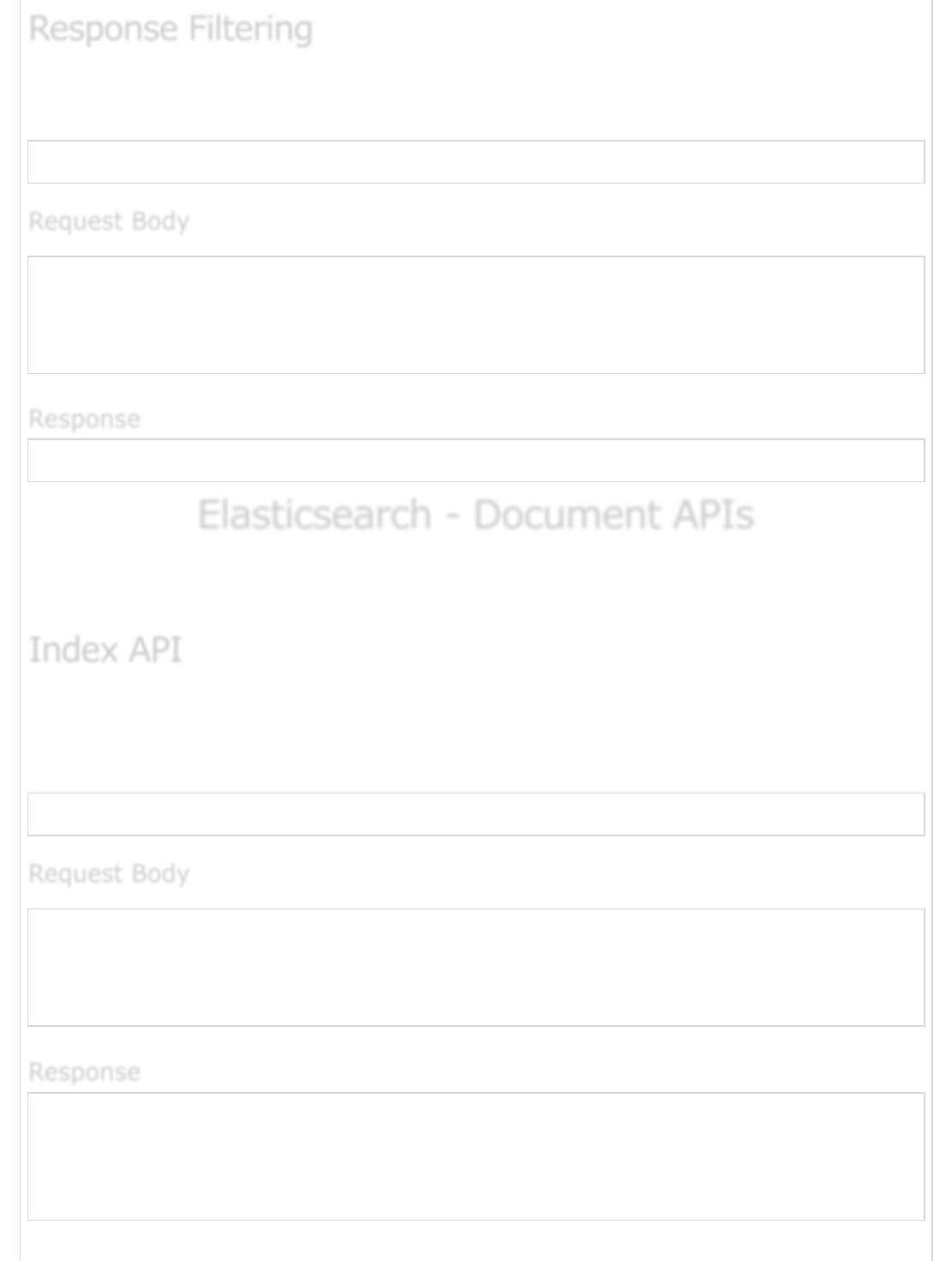
We can filter the response to less fields by adding them in the field_path parameter. For
example,
POST http://localhost:9200/schools/_search?filter_path = hits.total
{
"query":{
"match_all":{}
}
}
{"hits":{"total":3}}
Elasticsearch - Document APIsElasticsearch - Document APIs
Elasticsearch - Document APIs
Elasticsearch provides single document APIs and multi-document APIs, where the API call
is targeting single document and multiple documents respectively.
It helps to add or updates the JSON document in an index when a request is made to that
respective index with specific mapping. For example, the below request will add the JSON
object to index schools and under school mapping.
POST http://localhost:9200/schools/school/4
{
"name":"City School", "description":"ICSE", "street":"West End", "city":"Meerut",
"state":"UP", "zip":"250002", "location":[28.9926174, 77.692485], "fees":3500,
"tags":["fully computerized"], "rating":"4.5"
}
{
"_index":"schools", "_type":"school", "_id":"4", "_version":1,
"_shards":{"total":2, "successful":1,"failed":0}, "created":true
}
Response FilteringResponse Filtering
Response Filtering
Request BodyRequest Body
Request Body
ResponseResponse
Response
Index APIIndex API
Index API
Request BodyRequest Body
Request Body
ResponseResponse
Response

When a request is made to add JSON object to a particular index and if that index does not
exist then this API automatically creates that index and also the underlying mapping for
that particular JSON object. This functionality can be disabled by changing the values of
following parameters to false, which are present in elasticsearch.yml file.
action.auto_create_index:false
index.mapper.dynamic:false
You can also restrict the auto creation of index, where only index name with specific
patterns are allowed by changing the value of the following parameter −
action.auto_create_index:+acc*,-bank*
(where + indicates allowed and – indicates not allowed)
Elasticsearch also provides version control facility. We can use a version query parameter
to specify the version of a particular document. For example,
POST http://localhost:9200/schools/school/1?version = 1
{
"name":"Central School", "description":"CBSE Affiliation", "street":"Nagan",
"city":"paprola", "state":"HP", "zip":"176115", "location":[31.8955385, 76.8380405],
"fees":2200, "tags":["Senior Secondary", "beautiful campus"], "rating":"3.3"
}
{
"_index":"schools", "_type":"school", "_id":"1", "_version":2,
"_shards":{"total":2, "successful":1,"failed":0}, "created":false
}
There are two most important types of versioning; internal versioning is the default
version that starts with 1 and increments with each update, deletes included. The version
number can be set externally. To enable this functionality, we need to set version_type to
external.
Versioning is a real-time process and it is not affected by the real time search operations.
Automatic Index CreationAutomatic Index Creation
Automatic Index Creation
VersioningVersioning
Versioning
Request BodyRequest Body
Request Body
ResponseResponse
Response
Operation TypeOperation Type
Operation Type

The operation type is used to force a create operation, this helps to avoid the overwriting
of existing document.
POST http://localhost:9200/tutorials/chapter/1?op_type = create
{
"Text":"this is chapter one"
}
{
"_index":"tutorials", "_type":"chapter", "_id":"1", "_version":1,
"_shards":{"total":2, "successful":1, "failed":0}, "created":true
}
When ID is not specified in index operation, then Elasticsearch automatically generates id
for that document.
You can define the parent of any document by passing the id of parent document in parent
URL query parameter.
POST http://localhost:9200/tutorials/article/1?parent = 1
{
"Text":"This is article 1 of chapter 1"
}
Note − If you get exception while executing this example, please recreate the index by
adding the following in the index.
{
"mappings": {
"chapter": {},
"article": {
"_parent": {
"type": "chapter"
}
}
}
}
Request BodyRequest Body
Request Body
ResponseResponse
Response
Automatic ID generationAutomatic ID generation
Automatic ID generation
Parents and ChildrenParents and Children
Parents and Children
Request BodyRequest Body
Request Body

By default, the index operation will wait on the primary shard to become available for up to
1 minute before failing and responding with an error. This timeout value can be changed
explicitly by passing a value to timeout parameter.
POST http://localhost:9200/tutorials/chapter/2?timeout = 3m
{
"Text":"This is chapter 2 waiting for primary shard for 3 minutes"
}
API helps to extract type JSON object by performing a get request for a particular
document. For example,
GET http://localhost:9200/schools/school/1
{
"_index":"schools", "_type":"school", "_id":"1", "_version":2,
"found":true, "_source":{
"name":"Central School", "description":"CBSE Affiliation",
"street":"Nagan", "city":"paprola", "state":"HP", "zip":"176115",
"location":[31.8955385,76.8380405], "fees":2200,
"tags":["Senior Secondary", "beautiful campus"], "rating":"3.3"
}
}
This operation is real time and does not get affected by the refresh rate of Index.
You can also specify the version, then Elasticsearch will fetch that version of
document only.
You can also specify the _all in the request, so that the Elasticsearch can search for
that document id in every type and it will return the first matched document.
You can also specify the fields you want in your result from that particular
document.
GET http://localhost:9200/schools/school/1?fields = name,fees
TimeoutTimeout
Timeout
Request BodyRequest Body
Request Body
Get APIGet API
Get API
ResponseResponse
Response

……………………..
"fields":{
"name":["Central School"], "fees":[2200]
}
……………………..
You can also fetch the source part in your result by just adding _source part in your get
request.
GET http://localhost:9200/schools/school/1/_source
{
"name":"Central School", "description":"CBSE Afiliation", "street":"Nagan",
"city":"paprola", "state":"HP", "zip":"176115", "location":[31.8955385, 76.8380405],
"fees":2200, "tags":["Senior Secondary", "beatiful campus"], "rating":"3.3"
}
You can also refresh the shard before doing get operation by set refresh parameter to true.
You can delete a particular index, mapping or a document by sending a HTTP DELETE
request to Elasticsearch. For example,
DELETE http://localhost:9200/schools/school/4
{
"found":true, "_index":"schools", "_type":"school", "_id":"4", "_version":2,
"_shards":{"total":2, "successful":1, "failed":0}
}
Version of the document can be specified to delete that particular version.
Routing parameter can be specified to delete the document from a particular user
and the operation fails if the document does not belong to that particular user.
In this operation, you can specify refresh and timeout option same like GET API.
ResponseResponse
Response
ResponseResponse
Response
Delete APIDelete API
Delete API
ResponseResponse
Response
Update APIUpdate API
Update API

Script is used for performing this operation and versioning is used to make sure that no
updates have happened during the get and re-index. For example, update the fees of
school using script −
POST http://localhost:9200/schools_gov/school/1/_update
{
"script":{
"inline": "ctx._source.fees+ = inc", "params":{
"inc": 500
}
}
}
{
"_index":"schools_gov", "_type":"school", "_id":"1", "_version":2,
"_shards":{"total":2, "successful":1, "failed":0}
}
Note − If you get script exception, it is recommended to add the following lines in
elastcisearch.yml
script.inline: on
script.indexed: on
You can check the update by sending get request to the updated document.
GET http://localhost:9200/schools_gov/school/1
It possesses same functionality like GET API, but this get request can return more than
one document. We use a doc array to specify the index, type and id of all the documents
that need to be extracted.
POST http://localhost:9200/_mget
{
"docs":[
{
"_index": "schools", "_type": "school", "_id": "1"
},
{
Request BodyRequest Body
Request Body
ResponseResponse
Response
Multi Get APIMulti Get API
Multi Get API
Request BodyRequest Body
Request Body
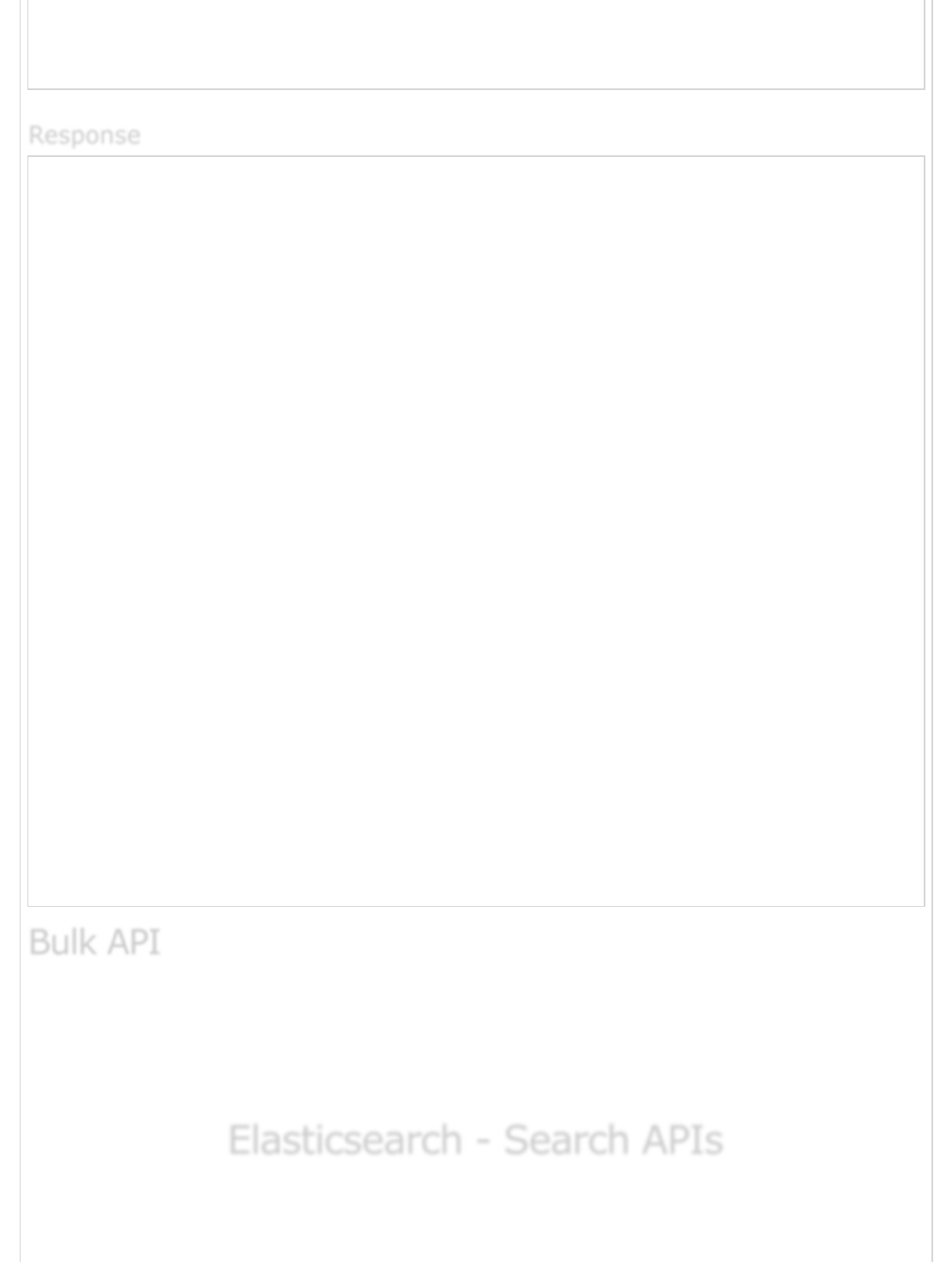
"_index":"schools_gev", "_type":"school", "_id": "2"
}
]
}
{
"docs":[
{
"_index":"schools", "_type":"school", "_id":"1",
"_version":1, "found":true, "_source":{
"name":"Central School", "description":"CBSE Afiliation",
"street":"Nagan", "city":"paprola", "state":"HP", "zip":"176115",
"location":[31.8955385,76.8380405], "fees":2000,
"tags":["Senior Secondary", "beatiful campus"], "rating":"3.5"
}
},
{
"_index":"schools_gev", "_type":"school", "_id":"2", "error":{
"root_cause":[{
"type":"index_not_found_exception", "reason":"no such index",
"index":"schools_gev"
}],
"type":"index_not_found_exception", "reason":"no such index",
"index":"schools_gev"
}
}
]
}
This API is used to upload or delete the JSON objects in bulk by making multiple
index/delete operations in a single request. We need to add “_bulk” keyword to call this
API. The example of this API is already performed in populate Elasticsearch article. All
other functionalities are same as of GET API.
Elasticsearch - Search APIsElasticsearch - Search APIs
Elasticsearch - Search APIs
This API is used to search content in Elasticsearch. Either a user can search by sending a
get request with query string as a parameter or a query in the message body of post
ResponseResponse
Response
Bulk APIBulk API
Bulk API

request. Mainly all the search APIS are multi-index, multi-type.
Elasticsearch allows us to search for the documents present in all the indices or in some
specific indices. For example, if we need to search all the documents with a name that
contains central.
GET http://localhost:9200/_search?q = name:central
{
"took":78, "timed_out":false, "_shards":{"total":10, "successful":10, "failed":0},
"hits":{
"total":1, "max_score":0.19178301, "hits":[{
"_index":"schools", "_type":"school", "_id":"1", "_score":0.19178301,
"_source":{
"name":"Central School", "description":"CBSE Affiliation",
"street":"Nagan", "city":"paprola", "state":"HP", "zip":"176115",
"location":[31.8955385, 76.8380405], "fees":2000,
"tags":["Senior Secondary", "beautiful campus"], "rating":"3.5"
}
}]
}
}
Or, we can search for the same in schools, schools_gov indices −
GET http://localhost:9200/schools,schools_gov/_search?q = name:model
We can also search all the documents in an index across all types or in some specified
type. For example,
Get http://localhost:9200/schools/_search?q = tags:sports
{
"took":16, "timed_out":false, "_shards":{"total":5, "successful":5, "failed":0},
"hits":{
"total":1, "max_score":0.5, "hits":[{
"_index":"schools", "_type":"school", "_id":"2", "_score":0.5,
"_source":{
Multi-IndexMulti-Index
Multi-Index
ResponseResponse
Response
Multi-TypeMulti-Type
Multi-Type
ResponseResponse
Response

"name":"Saint Paul School", "description":"ICSE Afiliation",
"street":"Dawarka", "city":"Delhi", "state":"Delhi", "zip":"110075",
"location":[28.5733056, 77.0122136], "fees":5000,
"tags":["Good Faculty", "Great Sports"], "rating":"4.5"
}
}]
}
}
Many parameters can be passed in a search operation using Uniform Resource Identifier −
Sr.No Parameter & Description
1
Q
This parameter is used to specify query string.
2
lenient
Format based errors can be ignored by just setting this parameter to true. It is
false by default.
3
fields
This parameter helps us to get response from selective fields.
4
sort
We can get sorted result by using this parameter, the possible values for this
parameter is fieldName, fieldName:asc/fieldname:desc
5
timeout
We can restrict the search time by using this parameter and response only
contains the hits in that specified time. By default, there is no timeout.
6
terminate_after
We can restrict the response to a specified number of documents for each shard,
upon reaching which the query will terminate early. By default, there is no
terminate_after.
7from
URI SearchURI Search
URI Search

The starting from index of the hits to return. Defaults to 0.
8
size
It denotes the number of hits to return. Defaults to 10.
We can also specify query using query DSL in request body and there are many examples
already given in previous chapters like −
POST http://localhost:9200/schools/_search
{
"query":{
"query_string":{
"query":"up"
}
}
}
……………………………………………….
{
"_source":{
"name":"City School", "description":"ICSE", "street":"West End",
"city":"Meerut", "state":"UP", "zip":"250002", "location":[28.9926174, 77.692485],
"fees":3500, "tags":["Well equipped labs"],"rating":"4.5"
}
}
……………………………………………….
Elasticsearch - AggregationsElasticsearch - Aggregations
Elasticsearch - Aggregations
This framework collects all the data selected by the search query. This framework consists
of many building blocks, which help in building complex summaries of the data. The basic
structure of aggregation is presented below −
"aggregations" : {
"<aggregation_name>" : {
"<aggregation_type>" : {
<aggregation_body>
}
Request Body SearchRequest Body Search
Request Body Search
Request BodyRequest Body
Request Body
ResponseResponse
Response

[,"meta" : { [<meta_data_body>] } ]?
[,"aggregations" : { [<sub_aggregation>]+ } ]?
}
}
There are different types of aggregations, each with its own purpose −
These aggregations help in computing matrices from the field’s values of the aggregated
documents and sometime some values can be generated from scripts.
Numeric matrices are either single-valued like average aggregation or multi-valued
like stats.
This aggregation is used to get the average of any numeric field present in the aggregated
documents. For example,
POST http://localhost:9200/schools/_search
{
"aggs":{
"avg_fees":{"avg":{"field":"fees"}}
}
}
{
"took":44, "timed_out":false, "_shards":{"total":5, "successful":5, "failed":0},
"hits":{
"total":3, "max_score":1.0, "hits":[
{
"_index":"schools", "_type":"school", "_id":"2", "_score":1.0,
"_source":{
"name":"Saint Paul School", "description":"ICSE Affiliation",
"street":"Dawarka", "city":"Delhi", "state":"Delhi",
"zip":"110075", "location":[28.5733056, 77.0122136], "fees":5000,
"tags":["Good Faculty", "Great Sports"], "rating":"4.5"
}
},
{
"_index":"schools", "_type":"school", "_id":"1", "_score":1.0,
Metrics AggregationsMetrics Aggregations
Metrics Aggregations
Avg AggregationAvg Aggregation
Avg Aggregation
Request BodyRequest Body
Request Body
ResponseResponse
Response

"_source":{
"name":"Central School", "description":"CBSE Affiliation",
"street":"Nagan", "city":"paprola", "state":"HP", "zip":"176115",
"location":[31.8955385, 76.8380405], "fees":2200,
"tags":["Senior Secondary", "beautiful campus"], "rating":"3.3"
}
},
{
"_index":"schools", "_type":"school", "_id":"3", "_score":1.0,
"_source":{
"name":"Crescent School", "description":"State Board Affiliation",
"street":"Tonk Road", "city":"Jaipur", "state":"RJ",
"zip":"176114", "location":[26.8535922, 75.7923988], "fees":2500,
"tags":["Well equipped labs"], "rating":"4.5"
}
}
]
}, "aggregations":{"avg_fees":{"value":3233.3333333333335}}
}
If the value is not present in one or more aggregated documents, it gets ignored by
default. You can add a missing field in the aggregation for treating missing value as
default.
{
"aggs":{
"avg_fees":{
"avg":{
"field":"fees"
"missing":0
}
}
}
}
This aggregation gives the count of distinct values of a particular field. For example,
POST http://localhost:9200/schools*/_search
{
"aggs":{
"distinct_name_count":{"cardinality":{"field":"name"}}
}
}
Cardinality AggregationCardinality Aggregation
Cardinality Aggregation
Request BodyRequest Body
Request Body

………………………………………………
{
"name":"Government School", "description":"State Board Afiliation",
"street":"Hinjewadi", "city":"Pune", "state":"MH", "zip":"411057",
"location":[18.599752, 73.6821995], "fees":500, "tags":["Great Sports"],
"rating":"4"
},
{
"_index":"schools_gov", "_type": "school", "_id":"1", "_score":1.0,
"_source":{
"name":"Model School", "description":"CBSE Affiliation", "street":"silk city",
"city":"Hyderabad", "state":"AP", "zip":"500030",
"location":[17.3903703, 78.4752129], "fees":700,
"tags":["Senior Secondary", "beautiful campus"], "rating":"3"
}
}, "aggregations":{"disticnt_name_count":{"value":3}}
………………………………………………
Note − The value of cardinality is 3 because there are three distinct values in name —
Government, School and Model.
This aggregation generates all the statistics about a specific numerical field in aggregated
documents. For example,
POST http://localhost:9200/schools/school/_search
{
"aggs" : {
"fees_stats" : { "extended_stats" : { "field" : "fees" } }
}
}
………………………………………………
{
"aggregations":{
"fees_stats":{
"count":3, "min":2200.0, "max":5000.0,
ResponseResponse
Response
Extended Stats AggregationExtended Stats Aggregation
Extended Stats Aggregation
Request BodyRequest Body
Request Body
ResponseResponse
Response

"avg":3233.3333333333335, "sum":9700.0,
"sum_of_squares":3.609E7, "variance":1575555.555555556,
"std_deviation":1255.2113589175156,
"std_deviation_bounds":{
"upper":5743.756051168364, "lower":722.9106154983024
}
}
}
}
………………………………………………
This aggregation finds the max value of a specific numeric field in aggregated documents.
For example,
POST http://localhost:9200/schools*/_search
{
"aggs" : {
"max_fees" : { "max" : { "field" : "fees" } }
}
}
………………………………………………
{
aggregations":{"max_fees":{"value":5000.0}}
}
………………………………………………
This aggregation finds the max value of a specific numeric field in aggregated documents.
For example,
POST http://localhost:9200/schools*/_search
{
"aggs" : {
"min_fees" : { "min" : { "field" : "fees" } }
Max AggregationMax Aggregation
Max Aggregation
Request BodyRequest Body
Request Body
ResponseResponse
Response
Min AggregationMin Aggregation
Min Aggregation
Request BodyRequest Body
Request Body

}
}
………………………………………………
"aggregations":{"min_fees":{"value":500.0}}
………………………………………………
This aggregation calculates the sum of a specific numeric field in aggregated documents.
For example,
POST http://localhost:9200/schools*/_search
{
"aggs" : {
"total_fees" : { "sum" : { "field" : "fees" } }
}
}
………………………………………………
"aggregations":{"total_fees":{"value":10900.0}}
………………………………………………
There are some other metrics aggregations which are used in special cases like geo
bounds aggregation and geo centroid aggregation for the purpose of geo location.
These aggregations contain many buckets for different types of aggregations having a
criterion, which determines whether a document belongs to that bucket or not. The bucket
aggregations have been described below −
This bucket aggregation makes a collection of documents, which are mapped to parent
bucket. A type parameter is used to define the parent index. For example, we have a
brand and its different models, and then the model type will have the following _parent
field −
{
"model" : {
"_parent" : {
ResponseResponse
Response
Sum AggregationSum Aggregation
Sum Aggregation
Request BodyRequest Body
Request Body
ResponseResponse
Response
Bucket AggregationsBucket Aggregations
Bucket Aggregations
Children AggregationChildren Aggregation
Children Aggregation

"type" : "brand"
}
}
}
There are many other special bucket aggregations, which are useful in many other cases,
those are −
Date Histogram Aggregation
Date Range Aggregation
Filter Aggregation
Filters Aggregation
Geo Distance Aggregation
GeoHash grid Aggregation
Global Aggregation
Histogram Aggregation
IPv4 Range Aggregation
Missing Aggregation
Nested Aggregation
Range Aggregation
Reverse nested Aggregation
Sampler Aggregation
Significant Terms Aggregation
Terms Aggregation
You can add some data about the aggregation at the time of request by using meta tag
and can get that in response. For example,
POST http://localhost:9200/school*/report/_search
{
"aggs" : {
"min_fees" : { "avg" : { "field" : "fees" } ,
"meta" :{
"dsc" :"Lowest Fees"
}
}
}
}
Aggregation MetadataAggregation Metadata
Aggregation Metadata
Request BodyRequest Body
Request Body

………………………………………………
{
"aggregations":{"min_fees":{"meta":{"dsc":"Lowest Fees"}, "value":2180.0}}
}
………………………………………………
Elasticsearch - Index APIsElasticsearch - Index APIs
Elasticsearch - Index APIs
These APIs are responsible for managing all the aspects of index like settings, aliases,
mappings, index templates.
This API helps you to create index. Index can be created automatically when a user is
passing JSON objects to any index or it can be created before that. To create an index, you
just need to send a post request with settings, mappings and aliases or just a simple
request without body. For example,
POST http://localhost:9200/colleges
{"acknowledged":true}
Or, with some settings –
POST http://localhost:9200/colleges
{
"settings" : {
"index" : {
"number_of_shards" : 5, "number_of_replicas" : 3
}
}
}
{"acknowledged":true}
Or with mapping –
POST http://localhost:9200/colleges
ResponseResponse
Response
Create IndexCreate Index
Create Index
ResponseResponse
Response
Request BodyRequest Body
Request Body
ResponseResponse
Response
Request BodyRequest Body
Request Body

{
"settings" : {
"number_of_shards" : 3
},
"mappings" : {
"type1" : {
"_source" : { "enabled" : false }, "properties" : {
"college_name" : { "type" : "string" }, "college type" : {"type":"string"}
}
}
}
}
{"acknowledged":true}
Or, with alias –
POST http://localhost:9200/colleges
{
"aliases" : {
"alias_1" : {}, "alias_2" : {
"filter" : {
"term" : {"user" : "manu" }
},
"routing" : "manu"
}
}
}
{"acknowledged":true}
This API helps you to delete any index. You just need to pass a delete request with the URL
of that particular Index. For example,
DELETE http://localhost:9200/colleges
You can delete all indices by just using _all,*.
This API can be called by just sending get request to one or more than one indices. This
returns the information about index.
ResponseResponse
Response
Request BodyRequest Body
Request Body
ResponseResponse
Response
Delete IndexDelete Index
Delete Index
Get IndexGet Index
Get Index

GET http://localhost:9200/schools
{
"schools":{
"aliases":{}, "mappings":{
"school":{
"properties":{
"city":{"type":"string"}, "description":{"type":"string"},
"fees":{"type":"long"}, "location":{"type":"double"},
"name":{"type":"string"}, "rating":{"type":"string"},
"state":{"type":"string"}, "street":{"type":"string"},
"tags":{"type":"string"}, "zip":{"type":"string"}
}
}
},
"settings":{
"index":{
"creation_date":"1454409831535", "number_of_shards":"5",
"number_of_replicas":"1", "uuid":"iKdjTtXQSMCW4xZMhpsOVA",
"version":{"created":"2010199"}
}
},
"warmers":{}
}
}
You can get the information of all the indices by using _all or *.
Existence of an index can be determined by just sending a get request to that index. If the
HTTP response is 200, it exists; if it is 404, it does not exist.
It’s very easy to close or open one or more index by just adding _close or _open in post to
request to that index. For example,
POST http://localhost:9200/schools/_close
Or
POST http://localhost:9200/schools/_open
ResponseResponse
Response
Index ExistIndex Exist
Index Exist
Open / Close Index APIOpen / Close Index API
Open / Close Index API

This API helps to give an alias to any index by using _aliases keyword. Single alias can be
mapped to more than one and alias cannot have the same name as index. For example,
POST http://localhost:9200/_aliases
{
"actions" : [
{ "add" : { "index" : "schools", "alias" : "schools_pri" } }
]
}
{"acknowledged":true}
Then,
GET http://localhost:9200/schools_pri
………………………………………………
{"schools":{"aliases":{"schools_pri":{}},"}}
………………………………………………
You can get the index settings by just appending _settings keyword at the end of URL. For
example,
GET http://localhost:9200/schools/_settings
{
"schools":{
"settings":{
"index":{
"creation_date":"1454409831535", "number_of_shards":"5",
"number_of_replicas":"1", "uuid":"iKdjTtXQSMCW4xZMhpsOVA",
"version":{"created":"2010199"}
}
}
Index AliasesIndex Aliases
Index Aliases
Request BodyRequest Body
Request Body
ResponseResponse
Response
ResponseResponse
Response
Index SettingsIndex Settings
Index Settings
ResponseResponse
Response

}
}
This API helps to analyze the text and send the tokens with offset value and data type. For
example,
POST http://localhost:9200/_analyze
{
"analyzer" : "standard",
"text" : "you are reading this at tutorials point"
}
{
"tokens":[
{"token":"you", "start_offset":0, "end_offset":3, "type":"<ALPHANUM>", "position":0},
{"token":"are", "start_offset":4, "end_offset":7, "type":"<ALPHANUM>", "position":1},
{"token":"reading", "start_offset":8, "end_offset":15, "type":"<ALPHANUM>", "position":2},
{"token":"this", "start_offset":16, "end_offset":20, "type":"<ALPHANUM>", "position":3},
{"token":"at", "start_offset":21, "end_offset":23, "type":"<ALPHANUM>", "position":4},
{"token":"tutorials", "start_offset":24, "end_offset":33, "type":"<ALPHANUM>", "position":5},
{"token":"point", "start_offset":34, "end_offset":39, "type":"<ALPHANUM>", "position":6}
]
}
You can also analyze a text with any index, and then the text will be analyzed according to
the analyzer associated with that index.
You can also create index templates with mappings, which can be applied to new indices.
For example,
POST http://localhost:9200/_template/template_a
{
"template" : "tu*",
"settings" : {
"number_of_shards" : 3
},
AnalyzeAnalyze
Analyze
Request BodyRequest Body
Request Body
ResponseResponse
Response
Index TemplatesIndex Templates
Index Templates
Request BodyRequest Body
Request Body

"mappings" : {
"chapter" : {
"_source" : { "enabled" : false }
}
}
}
Any index that starts with “tu” will have the same settings as template_a.
This API helps you to extract statistics about a particular index. You just need to send a
get request with the index URL and _stats keyword at the end.
GET http://localhost:9200/schools/_stats
………………………………………………
{"_shards":{"total":10, "successful":5, "failed":0}, "_all":{"primaries":{"docs":{
"count":3, "deleted":0}}}, "store":{"size_in_bytes":16653, "throttle_time_in_millis":0},
………………………………………………
This API helps to clean the data from index memory and migrate it to index storage and
also cleans internal transaction log. For example,
GET http://localhost:9200/schools/_flush
{"_shards":{"total":10, "successful":5, "failed":0}}
Refresh is scheduled by default in Elasticsearch, but you can refresh one or more indices
explicitly by using _refresh. For example,
GET http://localhost:9200/schools/_refresh
{"_shards":{"total":10, "successful":5, "failed":0}}
Elasticsearch - Cluster APIsElasticsearch - Cluster APIs
Elasticsearch - Cluster APIs
Index StatsIndex Stats
Index Stats
ResponseResponse
Response
FlushFlush
Flush
ResponseResponse
Response
RefreshRefresh
Refresh
ResponseResponse
Response

This API is used for getting information about cluster and its nodes and making changes in
them. For calling this API, we need to specify the node name, address or _local. For
example,
GET http://localhost:9200/_nodes/_local
………………………………………………
{
"cluster_name":"elasticsearch", "nodes":{
"Vy3KxqcHQdm4cIM22U1ewA":{
"name":"Red Guardian", "transport_address":"127.0.0.1:9300",
"host":"127.0.0.1", "ip":"127.0.0.1", "version":"2.1.1",
"build":"40e2c53", "http_address":"127.0.0.1:9200",
}
}
}
………………………………………………
Or
Get http://localhost:9200/_nodes/127.0.0.1
Same as in the above example.
This API is used to get the status on the health of the cluster by appending health
keyword. For example,
GET http://localhost:9200/_cluster/health
{
"cluster_name":"elasticsearch", "status":"yellow", "timed_out":false,
"number_of_nodes":1, "number_of_data_nodes":1, "active_primary_shards":23,
"active_shards":23, "relocating_shards":0, "initializing_shards":0,
"unassigned_shards":23, "delayed_unassigned_shards":0, "number_of_pending_tasks":0,
"number_of_in_flight_fetch":0, "task_max_waiting_in_queue_millis":0,
"active_shards_percent_as_number":50.0
}
ResponseResponse
Response
ResponseResponse
Response
Cluster HealthCluster Health
Cluster Health
ResponseResponse
Response
Cluster StateCluster State
Cluster State

This API is used to get state information about a cluster by appending ‘state’ keyword URL.
The state information contains version, master node, other nodes, routing table, metadata
and blocks. For example,
GET http://localhost:9200/_cluster/state 10. Elasticsearch — Cluster APIs
………………………………………………
{
"cluster_name":"elasticsearch", "version":27, "state_uuid":"B3P7uHGKQUGsSsiX2rGYUQ",
"master_node":"Vy3KxqcHQdm4cIM22U1ewA",
}
………………………………………………
This API helps to retrieve statistics about cluster by using ‘stats’ keyword. This API returns
shard number, store size, memory usage, number of nodes, roles, OS, and file system. For
example,
GET http://localhost:9200/_cluster/stats
………………………………………………
{
"timestamp":1454496710020, "cluster_name":"elasticsearch", "status":"yellow",
"indices":{
"count":5, "shards":{
"total":23, "primaries":23, "replication":0.0,"
}
}
}
………………………………………………
This API is used for monitoring pending tasks in any cluster. Tasks are like create index,
update mapping, allocate shard, fail shard etc. For example,
ResponseResponse
Response
Cluster StatsCluster Stats
Cluster Stats
ResponseResponse
Response
Pending Cluster TasksPending Cluster Tasks
Pending Cluster Tasks

GET http://localhost:9200/_cluster/pending_tasks
This API is used for moving shard from one node to another or to cancel any allocation or
allocate any unassigned shard. For example,
POST http://localhost:9200/_cluster/reroute
{
"commands" : [
{
"move" :
{
"index" : "schools", "shard" : 2,
"from_node" : "nodea", "to_node" : "nodeb"
}
},
{
"allocate" : {
"index" : "test", "shard" : 1, "node" : "nodec"
}
}
]
}
This API allows you to update the settings of a cluster by using settings keyword. There
are two types of settings — persistent (applied across restarts) and transient (do not
survive a full cluster restart).
This API is used to retrieve the statistics of one more nodes of the cluster. Node stats are
almost the same as cluster. For example,
GET http://localhost:9200/_nodes/stats
………………………………………………
{
"cluster_name":"elasticsearch", "nodes":{
"Vy3KxqcHQdm4cIM22U1ewA":{
Cluster RerouteCluster Reroute
Cluster Reroute
Request BodyRequest Body
Request Body
Cluster Update SettingsCluster Update Settings
Cluster Update Settings
Node StatsNode Stats
Node Stats
ResponseResponse
Response
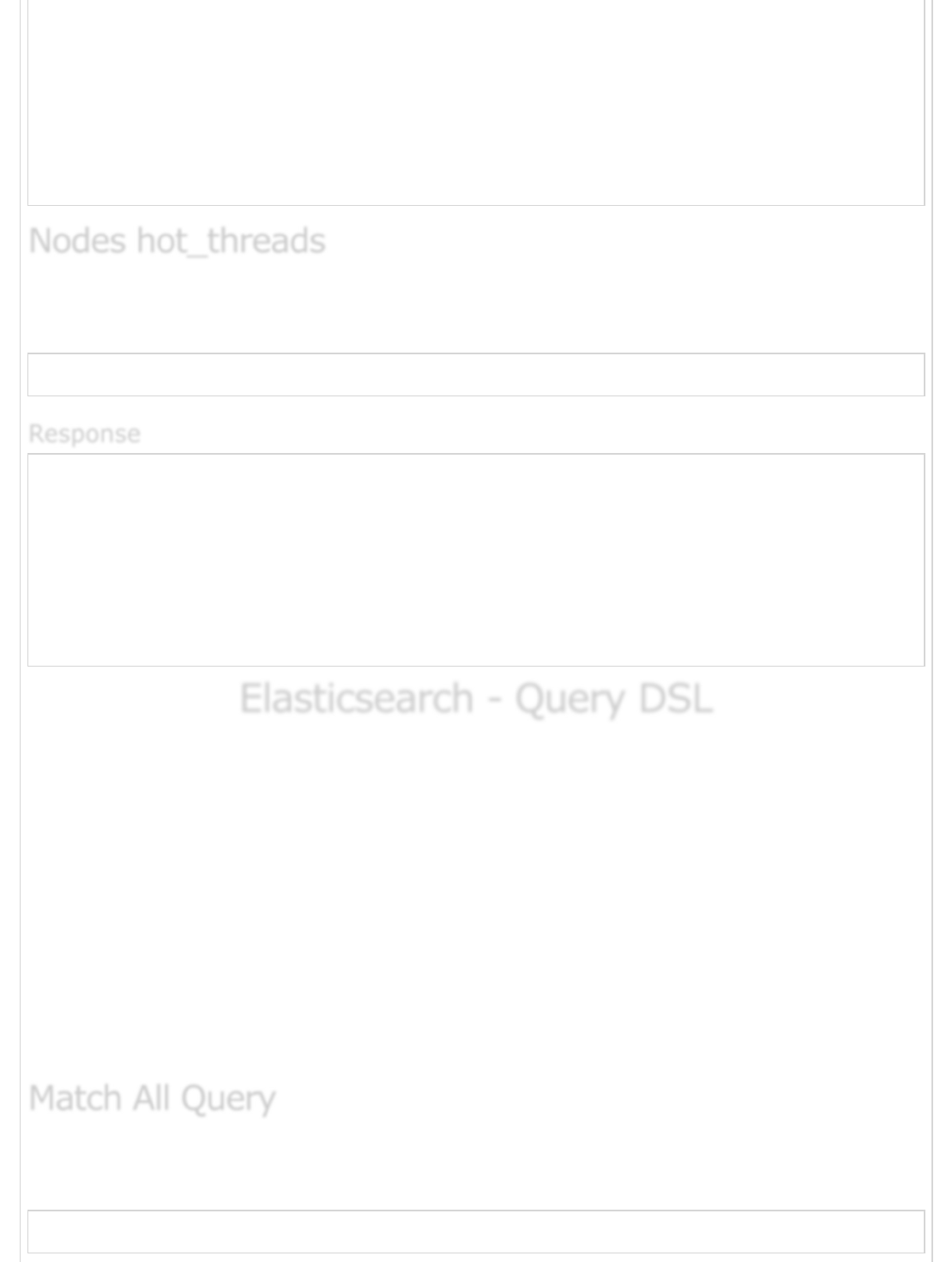
"timestamp":1454497097572, "name":"Red Guardian",
"transport_address":"127.0.0.1:9300", "host":"127.0.0.1", "ip":["127.0.0.1:9300",
}
}
}
………………………………………………
This API helps you to retrieve information about the current hot threads on each node in
cluster. For example,
GET http://localhost:9200/_nodes/hot_threads
………………………………………………
::: {Red Guardian} {Vy3KxqcHQdm4cIM22U1ewA} {127.0.0.1}{127.0.0.1:9300}Hot threads at
2016-02-03T10:59:48.856Z, interval = 500ms, busiestThreads = 3,
ignoreIdleThreads = true:0.0% (0s out of 500ms) cpu usage by thread 'Attach Listener'
unique snapshot
unique snapshot
………………………………………………
Elasticsearch - Query DSLElasticsearch - Query DSL
Elasticsearch - Query DSL
In Elasticsearch, searching is carried out by using query based on JSON. Query is made up
of two clauses −
Leaf Query Clauses − These clauses are match, term or range, which look for a
specific value in specific field.
Compound Query Clauses − These queries are a combination of leaf query
clauses and other compound queries to extract the desired information.
Elasticsearch supports a large number of queries. A query starts with a query key word
and then has conditions and filters inside in the form of JSON object. The different types of
queries have been described below −
This is the most basic query; it returns all the content and with the score of 1.0 for every
object. For example,
POST http://localhost:9200/schools*/_search
Nodes hot_threadsNodes hot_threads
Nodes hot_threads
ResponseResponse
Response
Match All QueryMatch All Query
Match All Query

{
"query":{
"match_all":{}
}
}
{
"took":1, "timed_out":false, "_shards":{"total":10, "successful":10, "failed":0},
"hits":{
"total":5, "max_score":1.0, "hits":[
{
"_index":"schools", "_type":"school", "_id":"2", "_score":1.0,
"_source":{
"name":"Saint Paul School", "description":"ICSE Affiliation",
"street":"Dawarka", "city":"Delhi", "state":"Delhi",
"zip":"110075", "location":[28.5733056, 77.0122136], "fees":5000,
"tags":["Good Faculty", "Great Sports"], "rating":"4.5"
}
},
{
"_index":"schools_gov", "_type":"school", "_id":"2", "_score":1.0,
"_source":{
"name":"Government School", "description":"State Board Affiliation",
"street":"Hinjewadi", "city":"Pune", "state":"MH", "zip":"411057",
"location":[18.599752, 73.6821995], "fees":500, "tags":["Great Sports"],
"rating":"4"
}
},
{
"_index":"schools", "_type":"school", "_id":"1", "_score":1.0,
"_source":{
"name":"Central School", "description":"CBSE Affiliation",
"street":"Nagan", "city":"paprola", "state":"HP",
"zip":"176115", "location":[31.8955385, 76.8380405],
"fees":2200, "tags":["Senior Secondary", "beautiful campus"],
"rating":"3.3"
}
},
Request BodyRequest Body
Request Body
ResponseResponse
Response

{
"_index":"schools_gov", "_type":"school", "_id":"1", "_score":1.0,
"_source":{
"name":"Model School", "description":"CBSE Affiliation",
"street":"silk city", "city":"Hyderabad", "state":"AP",
"zip":"500030", "location":[17.3903703, 78.4752129], "fees":700,
"tags":["Senior Secondary", "beautiful campus"], "rating":"3"
}
},
{
"_index":"schools", "_type":"school", "_id":"3", "_score":1.0,
"_source":{
"name":"Crescent School", "description":"State Board Affiliation",
"street":"Tonk Road", "city":"Jaipur", "state":"RJ", "zip":"176114",
"location":[26.8535922, 75.7923988], "fees":2500,
"tags":["Well equipped labs"], "rating":"4.5"
}
}
]
}
}
These queries are used to search a full body of text like a chapter or a news article. This
query works according to the analyzer associated with that particular index or document.
In this section, we will discuss the different types of full text queries.
This query matches a text or phrase with the values of one or more fields. For example,
POST http://localhost:9200/schools*/_search
{
"query":{
"match" : {
"city":"pune"
}
}
}
Full Text QueriesFull Text Queries
Full Text Queries
Match queryMatch query
Match query
Request BodyRequest Body
Request Body
ResponseResponse
Response

{
"took":1, "timed_out":false, "_shards":{"total":10, "successful":10, "failed":0},
"hits":{
"total":1, "max_score":0.30685282, "hits":[{
"_index":"schools_gov", "_type":"school", "_id":"2", "_score":0.30685282,
"_source":{
"name":"Government School", "description":"State Board Afiliation",
"street":"Hinjewadi", "city":"Pune", "state":"MH", "zip":"411057",
"location":[18.599752, 73.6821995], "fees":500,
"tags":["Great Sports"], "rating":"4"
}
}]
}
}
This query matches a text or phrase with more than one field. For example,
POST http://localhost:9200/schools*/_search
{
"query":{
"multi_match" : {
"query": "hyderabad",
"fields": [ "city", "state" ]
}
}
}
{
"took":16, "timed_out":false, "_shards":{"total":10, "successful":10, "failed":0},
"hits":{
"total":1, "max_score":0.09415865, "hits":[{
"_index":"schools_gov", "_type":"school", "_id":"1", "_score":0.09415865,
"_source":{
"name":"Model School", " description":"CBSE Affiliation",
"street":"silk city", "city":"Hyderabad", "state":"AP",
"zip":"500030", "location":[17.3903703, 78.4752129], "fees":700,
"tags":["Senior Secondary", "beautiful campus"], "rating":"3"
}
}]
multi_match querymulti_match query
multi_match query
Request BodyRequest Body
Request Body
ResponseResponse
Response

}
}
This query uses query parser and query_string keyword. For example,
POST http://localhost:9200/schools/_search
{
"query":{
"query_string":{
"query":"good faculty"
}
}
}
{
"took":16, "timed_out":false, "_shards":{"total":10, "successful":10, "failed":0},
"hits":{
"total":1, "max_score":0.09492774, "hits":[{
"_index":"schools", "_type":"school", "_id":"2", "_score":0.09492774,
"_source":{
"name":"Saint Paul School", "description":"ICSE Affiliation",
"street":"Dawarka", "city":"Delhi", "state":"Delhi",
"zip":"110075", "location":[28.5733056, 77.0122136],
"fees":5000, "tags":["Good Faculty", "Great Sports"],
"rating":"4.5"
}
}]
}
}
These queries mainly deal with structured data like numbers, dates and emuns. For
example,
POST http://localhost:9200/schools/_search
Query String QueryQuery String Query
Query String Query
Request BodyRequest Body
Request Body
ResponseResponse
Response
Term Level QueriesTerm Level Queries
Term Level Queries
Request BodyRequest Body
Request Body

{
"query":{
"term":{"zip":"176115"}
}
}
{
"took":1, "timed_out":false, "_shards":{"total":10, "successful":10, "failed":0},
"hits":{
"total":1, "max_score":0.30685282, "hits":[{
"_index":"schools", "_type":"school", "_id":"1", "_score":0.30685282,
"_source":{
"name":"Central School", "description":"CBSE Affiliation",
"street":"Nagan", "city":"paprola", "state":"HP", "zip":"176115",
"location":[31.8955385, 76.8380405], "fees":2200,
"tags":["Senior Secondary", "beautiful campus"], "rating":"3.3"
}
}]
}
}
This query is used to find the objects having values between the ranges of values. For this,
we need to use operators like −
gte − greater than equal to
gt − greater-than
lte − less-than equal to
lt − less-than
For example,
POST http://localhost:9200/schools*/_search
{
"query":{
"range":{
"rating":{
"gte":3.5
}
}
ResponseResponse
Response
Range QueryRange Query
Range Query
Request BodyRequest Body
Request Body

}
}
{
"took":31, "timed_out":false, "_shards":{"total":10, "successful":10, "failed":0},
"hits":{
"total":3, "max_score":1.0, "hits":[
{
"_index":"schools", "_type":"school", "_id":"2", "_score":1.0,
"_source":{
"name":"Saint Paul School", "description":"ICSE Affiliation",
"street":"Dawarka", "city":"Delhi", "state":"Delhi",
"zip":"110075", "location":[28.5733056, 77.0122136], "fees":5000,
"tags":["Good Faculty", "Great Sports"], "rating":"4.5"
}
},
{
"_index":"schools_gov", "_type":"school", "_id":"2", "_score":1.0,
"_source":{
"name":"Government School", "description":"State Board Affiliation",
"street":"Hinjewadi", "city":"Pune", "state":"MH", "zip":"411057",
"location":[18.599752, 73.6821995] "fees":500,
"tags":["Great Sports"], "rating":"4"
}
},
{
"_index":"schools", "_type":"school", "_id":"3", "_score":1.0,
"_source":{
"name":"Crescent School", "description":"State Board Affiliation",
"street":"Tonk Road", "city":"Jaipur", "state":"RJ", "zip":"176114",
"location":[26.8535922, 75.7923988], "fees":2500,
"tags":["Well equipped labs"], "rating":"4.5"
}
}
]
}
}
Other types of term level queries are −
Exists query − If a certain field has non null value.
ResponseResponse
Response

Missing query − This is completely opposite to exists query, this query searches
for objects without specific fields or fields having null value.
Wildcard or regexp query − This query uses regular expressions to find patterns
in the objects.
Type query − documents with specific type. For example,
POST http://localhost:9200/schools*/_search
{
"query":{
"type" : {
"value" : "school"
}
}
}
All the school JSON objects present in the specified indices.
These queries are a collection of different queries merged with each other by using
Boolean operators like and, or, not or for different indices or having function calls etc. For
example,
POST http://localhost:9200/schools*/_search
{
"query":{
"filtered":{
"query":{
"match":{
"state":"UP"
}
},
"filter":{
"range":{
"rating":{
"gte":4.0
}
}
}
}
Request BodyRequest Body
Request Body
ResponseResponse
Response
Compound QueriesCompound Queries
Compound Queries
Request BodyRequest Body
Request Body

}
}
{
"took":16, "timed_out":false, "_shards":{"total":10, "successful":10, "failed":0},
"hits":{"total":0, "max_score":null, "hits":[]}
}
These queries are used where more than one mapping or document is included. There are
two types of joining queries −
These queries deal with nested mapping (you will read more about it in the next chapter).
These queries are used to retrieve child or parent of the document, which got match in the
query. For example,
POST http://localhost:9200/tutorials/_search
{
"query":
{
"has_child" : {
"type" : "article", "query" : {
"match" : {
"Text" : "This is article 1 of chapter 1"
}
}
}
}
}
{
"took":21, "timed_out":false, "_shards":{"total":5, "successful":5, "failed":0},
"hits":{
"total":1, "max_score":1.0, "hits":[{
"_index":"tutorials", "_type":"chapter", "_id":"1", "_score":1.0,
"_source":{
"Text":"this is chapter one"
ResponseResponse
Response
Joining QueriesJoining Queries
Joining Queries
Nested QueryNested Query
Nested Query
has_child and has_parent querieshas_child and has_parent queries
has_child and has_parent queries
Request BodyRequest Body
Request Body
ResponseResponse
Response

}
}]
}
}
These queries deal with geo locations and geo points. These queries help to find out
schools or any other geographical object near to any location. You need to use geo point
data type. For example,
POST http://localhost:9200/schools*/_search
{
"query":{
"filtered":{
"filter":{
"geo_distance":{
"distance":"100km",
"location":[32.052098, 76.649294]
}
}
}
}
}
{
"took":6, "timed_out":false, "_shards":{"total":10, "successful":10, "failed":0},
"hits":{
"total":2, "max_score":1.0, "hits":[
{
"_index":"schools", "_type":"school", "_id":"2", "_score":1.0,
"_source":{
"name":"Saint Paul School", "description":"ICSE Affiliation",
"street":"Dawarka", "city":"Delhi", "state":"Delhi", "zip":"110075",
"location":[28.5733056, 77.0122136], "fees":5000,
"tags":["Good Faculty", "Great Sports"], "rating":"4.5"
}
},
{
"_index":"schools", "_type":"school", "_id":"1", "_score":1.0,
"_source":{
"name":"Central School", "description":"CBSE Affiliation",
Geo QueriesGeo Queries
Geo Queries
Request BodyRequest Body
Request Body
ResponseResponse
Response

"street":"Nagan", "city":"paprola", "state":"HP", "zip":"176115",
"location":[31.8955385, 76.8380405], "fees":2000,
"tags":["Senior Secondary", "beautiful campus"], "rating":"3.5"
}
}
]
}
}
Note − If you get an exception while performing the above example, please add the
following mapping to your index.
{
"mappings":{
"school":{
"_all":{
"enabled":true
},
"properties":{
"location":{
"type":"geo_point"
}
}
}
}
}
Elasticsearch - MappingElasticsearch - Mapping
Elasticsearch - Mapping
Mapping is the outline of the documents stored in an index. It defines the data type like
geo_point or string and format of the fields present in the documents and rules to control
the mapping of dynamically added fields. For example,
POST http://localhost:9200/bankaccountdetails
{
"mappings":{
"report":{
"_all":{
"enabled":true
},
"properties":{
"name":{ "type":"string"}, "date":{ "type":"date"},
"balance":{ "type":"double"}, "liability":{ "type":"double"}
}
}
}
}
Request BodyRequest Body
Request Body

{"acknowledged":true}
Elasticsearch supports a number of different datatypes for the fields in a document. The
following data types are used to store fields in Elasticsearch −
These are the basic data types supported by almost all the systems like integer, long,
double, short, byte, double, float, string, date, Boolean and binary.
These data types are a combination of core data types. Like array, JSON object and nested
data type. Following is the example of nested data type −
POST http://localhost:9200/tabletennis/team/1
{
"group" : "players",
"user" : [
{
"first" : "dave", "last" : "jones"
},
{
"first" : "kevin", "last" : "morris"
}
]
}
{
"_index":"tabletennis", "_type":"team", "_id":"1", "_version":1,
"_shards":{"total":2, "successful":1, "failed":0}, "created":true
}
These data types are used for defining geographic properties. For instance, geo_point is
used for defining longitude and latitude, and geo_shape for defining different geometric
shapes like rectangle.
ResponseResponse
Response
Field Data TypesField Data Types
Field Data Types
Core Data TypesCore Data Types
Core Data Types
Complex Data TypesComplex Data Types
Complex Data Types
Request BodyRequest Body
Request Body
ResponseResponse
Response
Geo Data TypesGeo Data Types
Geo Data Types
Specialized Data TypesSpecialized Data Types
Specialized Data Types

These data types are used for special purposes like IPv4 (“ip”) accepts IP address,
completion data type is used to support auto-complete suggestions and token_count for
counting the number of tokens in a string.
Each index has one or more mapping types, which are used to divide the documents of an
index into logical groups. Mapping can be different from each other on the basis of the
following parameters −
These fields provide information about the mappings and the other objects associated with
it. Like _index, _type, _id, and _source fields.
Different mapping contains different number of fields and fields with different data types.
Elasticsearch provides a user-friendly mechanism for the automatic creation of mapping. A
user can post the data directly to any undefined mapping and Elasticsearch will
automatically create the mapping, which is called dynamic mapping. For example,
POST http://localhost:9200/accountdetails/tansferreport
{
"from_acc":"7056443341", "to_acc":"7032460534",
"date":"11/1/2016", "amount":10000
}
{
"_index":"accountdetails", "_type":"tansferreport",
"_id":"AVI3FeH0icjGpNBI4ake", "_version":1,
"_shards":{"total":2, "successful":1, "failed":0},
"created":true
}
The mapping parameters define the structure of mapping, information about fields and
about storage and how the mapped data will be analyzed at the time of searching. These
Mapping TypesMapping Types
Mapping Types
Meta-FieldsMeta-Fields
Meta-Fields
FieldsFields
Fields
Dynamic MappingDynamic Mapping
Dynamic Mapping
Request BodyRequest Body
Request Body
ResponseResponse
Response
Mapping ParametersMapping Parameters
Mapping Parameters

are the following mapping parameters −
analyzer
boost
coerce
copy_to
doc_values
dynamic
enabled
fielddata
geohash
geohash_precision
geohash_prefix
format
ignore_above
ignore_malformed
include_in_all
index_options
lat_lon
index
fields
norms
null_value
position_increment_gap
properties
search_analyzer
similarity
store
term_vector
Elasticsearch - AnalysisElasticsearch - Analysis
Elasticsearch - Analysis
When a query is processed during a search operation , the content in any index is analyzed
by analysis module. This module consists of analyzer, tokenizer, tokenfilters and charfilters.
If no analyzer is defined, then by default the built in analyzers, token, filters and
tokenizers get registered with analysis module. For example.

POST http://localhost:9200/pictures
{
"settings": {
"analysis": {
"analyzer": {
"index_analyzer": {
"tokenizer": "standard", "filter": [
"standard", "my_delimiter", "lowercase", "stop",
"asciifolding", "porter_stem"
]
},
"search_analyzer": {
"tokenizer": "standard", "filter": [
"standard", "lowercase", "stop", "asciifolding", "porter_stem"
]
}
},
"filter": {
"my_delimiter": {
"type": "word_delimiter",
"generate_word_parts": true,
"catenate_words": true,
"catenate_numbers": true,
"catenate_all": true,
"split_on_case_change": true,
"preserve_original": true,
"split_on_numerics": true,
"stem_english_possessive": true
}
}
}
}
}
An analyzer consists of a tokenizer and optional token filters. These analyzers are
registered in analysis module with logical names, which can be referenced either in
mapping definitions or in some APIs. There are a number of default analyzers as follows −
Sr.No Analyzer & Description
1
Standard analyzer (standard)
stopwords and max_token_length setting can be set for this analyzer. By
default, stopwords list is empty and max_token_length is 255.
2Simple analyzer (simple)
Request BodyRequest Body
Request Body
AnalyzersAnalyzers
Analyzers

This analyzer is composed of lowercase tokenizer.
3
Whitespace analyzer (whitespace)
This analyzer is composed of whitespace tokenizer.
4
Stop analyzer (stop)
stopwords and stopwords_path can be configured. By default stopwords
initialized to English stop words and stopwords_path contains path to a text file
with stop words.
5
Keyword analyzer (keyword)
This analyzer tokenizes an entire stream as a single token. It can be used for zip
code.
6
Pattern analyzer (pattern)
This analyzer mainly deals with regular expressions. Settings like lowercase,
pattern, flags, stopwords can be set in this analyzer.
7
Language analyzer
This analyzer deals with languages like hindi, arabic, ducth etc.
8
Snowball analyzer (snowball)
This analyzer uses the standard tokenizer, with standard filter, lowercase filter,
stop filter, and snowball filter.
9
Custom analyzer (custom)
This analyzer is used to create customized analyzer with a tokenizer with
optional token filters and char filters. Settings like tokenizer, filter, char_filter
and position_increment_gap can be configured in this analyzer.
Tokenizers are used for generating tokens from a text in Elasticsearch. Text can be broken
down into tokens by taking whitespace or other punctuations into account. Elasticsearch
has plenty of built-in tokenizers, which can be used in custom analyzer.
Sr.No Tokenizer & Description
TokenizersTokenizers
Tokenizers

1
Standard tokenizer (standard)
This is built on grammar based tokenizer and max_token_length can be
configured for this tokenizer.
2
Edge NGram tokenizer (edgeNGram)
Settings like min_gram, max_gram, token_chars can be set for this tokenizer.
3
Keyword tokenizer (keyword)
This generates entire input as an output and buffer_size can be set for this.
4
Letter tokenizer (letter)
This captures the whole word until a non-letter is encountered.
5
Lowercase tokenizer (lowercase)
This works the same as the letter tokenizer, but after creating tokens, it changes
them to lower case.
6
NGram Tokenizer (nGram)
Settings like min_gram (default value is 1), max_gram (default value is 2) and
token_chars can be set for this tokenizer.
7
Whitespace tokenizer (whitespace)
This divides text on the basis of whitespaces.
8
Pattern tokenizer (pattern)
This uses regular expressions as a token separator. Pattern, flags and group
settings can be set for this tokenizer.
9
UAX Email URL Tokenizer (uax_url_email)
This works same lie standard tokenizer but it treats email and URL as single
token.
10 Path hierarchy tokenizer (path_hierarchy)
This tokenizer generated all the possible paths present in the input directory
path. Settings available for this tokenizer are delimiter (defaults to /),

replacement, buffer_size (defaults to 1024), reverse (defaults to false) and skip
(defaults to 0).
11
Classic tokenizer (classic)
This works on the basis of grammar based tokens. max_token_length can be set
for this tokenizer.
12
Thai tokenizer (thai)
This tokenizer is used for Thai language and uses built-in Thai segmentation
algorithm.
Token filters receive input from tokenizers and then these filters can modify, delete or add
text in that input. Elasticsearch offers plenty of built-in token filters. Most of them have
already been explained in previous sections.
These filters process the text before tokenizers. Character filters look for special characters
or html tags or specified pattern and then either delete then or change them to
appropriate words like ‘&’ to and, delete html markup tags. Here is an example of analyzer
with synonym specified in synonym.txt −
{
"settings":{
"index":{
"analysis":{
"analyzer":{
"synonym":{
"tokenizer":"whitespace", "filter":["synonym"]
}
},
"filter":{
"synonym":{
"type":"synonym", "synonyms_path":"synonym.txt", "ignore_case":"true"
}
}
}
}
}
}
Elasticsearch - ModulesElasticsearch - Modules
Elasticsearch - Modules
Token FiltersToken Filters
Token Filters
Character FiltersCharacter Filters
Character Filters

Elasticsearch is composed of a number of modules, which are responsible for its
functionality. These modules have the following two types of settings −
Static Settings − These settings need to be configured in config
(elasticsearch.yml) file before starting Elasticsearch. You need to update all the
concern nodes in the cluster to reflect the changes by these settings.
Dynamic Settings − These settings can be set on live Elasticsearch.
We will discuss the different modules of Elasticsearch in the following sections of this
chapter.
Cluster level settings decide the allocation of shards to different nodes and reallocation of
shards to rebalance cluster. These are the following settings to control shard allocation −
Setting Possible value Description
cluster.routing.allocation.enable
all This default value allows shard
allocation for all kinds of shards.
primaries This allows shard allocation only for
primary shards.
new_primaries This allows shard allocation only for
primary shards for new indices.
none This does not allow any shard
allocations.
cluster.routing.allocation
.node_concurrent_recoveries
Numeric value
(by default 2)
This restricts the number of concurrent
shard recovery.
cluster.routing.allocation
.node_initial_primaries_recoveries
Numeric value
(by default 4)
This restricts the number of parallel
initial primary recoveries.
cluster.routing.allocation
.same_shard.host
Boolean value
(by default false)
This restricts the allocation of more
than one replica of the same shard in
the same physical node.
indices.recovery.concurrent
_streams
Numeric value
(by default 3)
This controls the number of open
network streams per node at the time
of shard recovery from peer shards.
indices.recovery.concurrent
_small_file_streams
Numeric value
(by default 2)
This controls the number of open
streams per node for small files having
Cluster-Level Routing and Shard AllocationCluster-Level Routing and Shard Allocation
Cluster-Level Routing and Shard Allocation
Cluster-Level Shard AllocationCluster-Level Shard Allocation
Cluster-Level Shard Allocation

size less than 5mb at the time of shard
recovery.
cluster.routing.rebalance.enable
all This default value allows balancing for
all kinds of shards.
primaries This allows shard balancing only for
primary shards.
replicas This allows shard balancing only for
replica shards.
none This does not allow any kind of shard
balancing.
cluster.routing.allocation
.allow_rebalance
always This default value always allows
rebalancing.
indices_primaries
_active
This allows rebalancing when all
primary shards in cluster are allocated.
Indices_all_active
This allows rebalancing when all the
primary and replica shards are
allocated.
cluster.routing.allocation.cluster
_concurrent_rebalance
Numeric value
(by default 2)
This restricts the number of concurrent
shard balancing in cluster.
cluster.routing.allocation
.balance.shard
Float value (by
default 0.45f)
This defines the weight factor for
shards allocated on every node.
cluster.routing.allocation
.balance.index
Float value (by
default 0.55f)
This defines the ratio of the number of
shards per index allocated on a
specific node.
cluster.routing.allocation
.balance.threshold
Non negative
float value (by
default 1.0f)
This is the minimum optimization
value of operations that should be
performed.
Setting Possible value Description
cluster.routing.allocation
.disk.threshold_enabled
Boolean value (by
default true)
This enables and disables disk
allocation decider.
cluster.routing.allocation
.disk.watermark.low
String value (by
default 85%)
This denotes maximum usage of
disk; after this point, no other shard
can be allocated to that disk.
Disk-based Shard AllocationDisk-based Shard Allocation
Disk-based Shard Allocation

cluster.routing.allocation
.disk.watermark.high
String value (by
default 90%)
This denotes the maximum usage at
the time of allocation; if this point is
reached at the time of allocation,
then Elasticsearch will allocate that
shard to another disk.
cluster.info.update.interval String value (by
default 30s)
This is the interval between disk
usages checkups.
cluster.routing.allocation
.disk.include_relocations
Boolean value (by
default true)
This decides whether to consider the
shards currently being allocated,
while calculating disk usage.
This module helps a cluster to discover and maintain the state of all the nodes in it. The
state of cluster changes when a node is added or deleted from a cluster. The cluster name
setting is used to create logical difference between different clusters. There are some
modules which help you to use the APIs provided by cloud vendors and those are −
Azure discovery
EC2 discovery
Google compute engine discovery
Zen discovery
This module maintains the cluster state and the shard data across full cluster restarts.
Following are the static settings of this module −
Setting Possible
value
Description
gateway.expected_
nodes
numeric
value (by
default 0)
The number of nodes that are expected to be in the cluster
for the recovery of local shards.
gateway.expected_
master_nodes
numeric
value (by
default 0)
The number of master nodes that are expected to be in the
cluster before start recovery.
gateway.expected_
data_nodes
numeric
value (by
default 0)
The number of data nodes expected in the cluster before
start recovery.
gateway.recover_ String value This specifies the time for which the recovery process will
DiscoveryDiscovery
Discovery
GatewayGateway
Gateway

after_time (by default
5m)
wait to start regardless of the number of nodes joined in
the cluster.
gateway.recover_ after_nodes
gateway.recover_after_ master_nodes
gateway.recover_after_ data_nodes
This module manages the communication between HTTP client and Elasticsearch APIs. This
module can be disabled by changing the value of http.enabled to false. The following are
the settings (configured in elasticsearch.yml) to control this module −
Sr.No Setting & Description
1
http.port
This is a port to access Elasticsearch and it ranges from 9200-9300.
2
http.publish_port
This port is for http clients and is also useful in case of firewall.
3
http.bind_host
This is a host address for http service.
4
http.publish_host
This is a host address for http client.
5
http.max_content_length
This is the maximum size of content in an http request. Its default value is
100mb.
6
http.max_initial_line_length
This is the maximum size of URL and its default value is 4kb.
7
http.max_header_size
This is the maximum http header size and its default value is 8kb.
HTTPHTTP
HTTP

8http.compression
This enables or disables support for compression and its default value is false.
9
http.pipelinig
This enables or disables HTTP pipelining.
10
http.pipelining.max_events
This restricts the number of events to be queued before closing an HTTP
request.
This module maintains the settings, which are set globally for every index. The following
settings are mainly related to memory usage −
This is used for preventing operation from causing an OutOfMemroyError. The setting
mainly restricts the JVM heap size. For example, indices.breaker.total.limit setting, which
defaults to 70% of JVM heap.
This is used mainly when aggregating on a field. It is recommended to have enough
memory to allocate it. The amount of memory used for the field data cache can be
controlled using indices.fielddata.cache.size setting.
This memory is used for caching the query results. This cache uses Least Recently Used
(LRU) eviction policy. Indices.queries.cahce.size setting controls the memory size of this
cache.
This buffer stores the newly created documents in the index and flushes them when the
buffer is full. Setting like indices.memory.index_buffer_size control the amount of heap
allocated for this buffer.
This cache is used to store local search data for every shard. Cache can be enabled during
the creation of index or can be disabled by sending URL parameter.
Disable cache - ?request_cache = true
Enable cache "index.requests.cache.enable": true
IndicesIndices
Indices
Circuit BreakerCircuit Breaker
Circuit Breaker
Fielddata CacheFielddata Cache
Fielddata Cache
Node Query CacheNode Query Cache
Node Query Cache
Indexing BufferIndexing Buffer
Indexing Buffer
Shard Request CacheShard Request Cache
Shard Request Cache
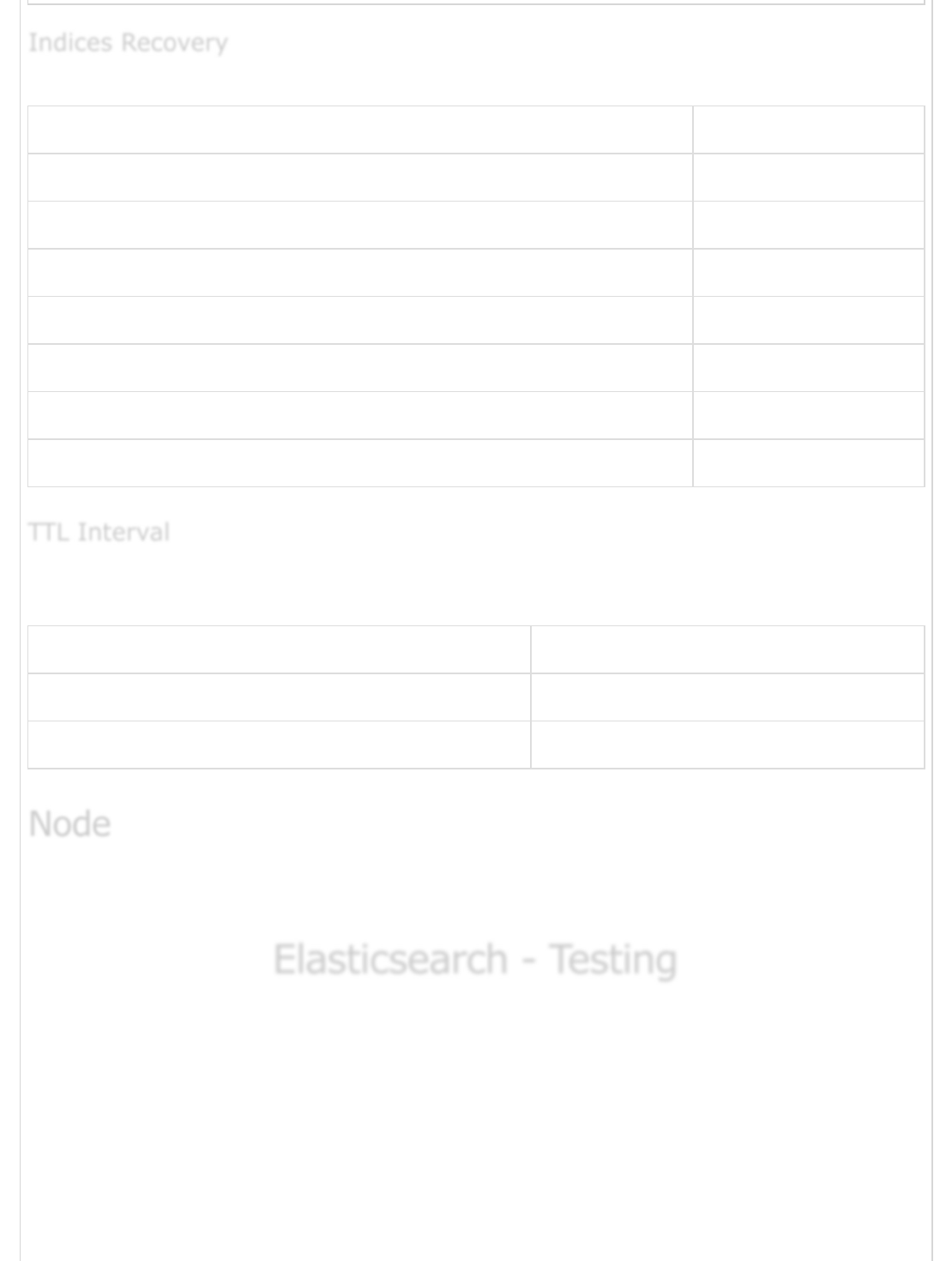
It controls the resources during recovery process. The following are the settings −
Setting Default value
indices.recovery.concurrent_streams 3
indices.recovery.concurrent_small_file_streams 2
indices.recovery.file_chunk_size 512kb
indices.recovery.translog_ops 1000
indices.recovery.translog_size 512kb
indices.recovery.compress true
indices.recovery.max_bytes_per_sec 40mb
Time to Live (TTL) interval defines the time of a document, after which the document gets
deleted. The following are the dynamic settings for controlling this process −
Setting Default value
indices.ttl.interval 60s
indices.ttl.bulk_size 1000
Each node has an option to be data node or not. You can change this property by changing
node.data setting. Setting the value as false defines that the node is not a data node.
Elasticsearch - TestingElasticsearch - Testing
Elasticsearch - Testing
Elasticsearch provides a jar file, which can be added to any java IDE and can be used to
test the code which is related to Elasticsearch. A range of tests can be performed by using
the framework provided by Elasticsearch −
Unit testing
Integration testing
Randomized testing
Indices RecoveryIndices Recovery
Indices Recovery
TTL IntervalTTL Interval
TTL Interval
NodeNode
Node

To start with testing, you need to add the Elasticsearch testing dependency to your
program. You can use maven for this purpose and can add the following in pom.xml.
<dependency>
<groupId>org.elasticsearch</groupId>
<artifactId>elasticsearch</artifactId>
<version>2.1.0</version>
</dependency>
EsSetup has been initialized to start and stop Elasticsearch node and also to create indices.
EsSetup esSetup = new EsSetup();
esSetup.execute() function with createIndex will create the indices, you need to specify
the settings, type and data.
Unit test is carried out by using JUnit and Elasticsearch test framework. Node and indices
can be created using Elasticsearch classes and in test method can be used to perform the
testing. ESTestCase and ESTokenStreamTestCase classes are used for this testing.
Integration testing uses multiple nodes in a cluster. ESIntegTestCase class is used for this
testing. There are various methods which make the job of preparing a test case easier.
Sr.No Method & Description
1
refresh()
All the indices in a cluster are refreshed
2
ensureGreen()
Ensures a green health cluster state
3
ensureYellow()
Ensures a yellow health cluster state
4
createIndex(name)
Create index with the name passed to this method
5flush()
All indices in cluster are flushed
Unit TestingUnit Testing
Unit Testing
Integration TestingIntegration Testing
Integration Testing

6
flushAndRefresh()
flush() and refresh()
7
indexExists(name)
Verifies the existence of specified index
8
clusterService()
Returns the cluster service java class
9
cluster()
Returns the test cluster class
Sr.No Method & Description
1ensureAtLeastNumNodes(n)
Ensures minimum number of nodes up in a cluster is more than or equal to
specified number.
2ensureAtMostNumNodes(n)
Ensures maximum number of nodes up in a cluster is less than or equal to
specified number.
3stopRandomNode()
To stop a random node in a cluster
4stopCurrentMasterNode()
To stop the master node
5stopRandomNonMaster()
To stop a random node in a cluster, which is not a master node
6buildNode()
Create a new node
Test Cluster MethodsTest Cluster Methods
Test Cluster Methods

7startNode(settings)
Start a new node
8nodeSettings()
Override this method for changing node settings
Client is used to access different nodes in a cluster and carry out some action.
ESIntegTestCase.client() method is used for getting a random client. Elasticsearch offers
other methods also to access client and those methods can be accessed using
ESIntegTestCase.internalCluster() method.
Sr.No Method & Description
1iterator()
This helps you to access all the available clients.
2masterClient()
This returns a client, which is communicating with master node.
3nonMasterClient()
This returns a client, which is not communicating with master node.
4clientNodeClient()
This returns a client currently up on client node.
This testing is used to test the user’s code with every possible data, so that there will be
no failure in future with any type of data. Random data is the best option to carry out this
testing.
In this testing, the Random class is instantiated by the instance provided by
RandomizedTest and offers many methods for getting different types of data.
Method Return value
Accessing ClientsAccessing Clients
Accessing Clients
Randomized TestingRandomized Testing
Randomized Testing
Generating Random DataGenerating Random Data
Generating Random Data

Previous Page Next Page
getRandom() Instance of random class
randomBoolean() Random boolean
randomByte() Random byte
randomShort() Random short
randomInt() Random integer
randomLong() Random long
randomFloat() Random float
randomDouble() Random double
randomLocale() Random locale
randomTimeZone() Random time zone
randomFrom() Random element from array
ElasticsearchAssertions and ElasticsearchGeoAssertions classes contain assertions, which
are used for performing some common checks at the time of testing. For example,
SearchResponse seearchResponse = client().prepareSearch();
assertHitCount(searchResponse, 6);
assertFirstHit(searchResponse, hasId("6"));
assertSearchHits(searchResponse, "1", "2", "3", "4",”5”,”6”);
AssertionsAssertions
Assertions
Advertisements
